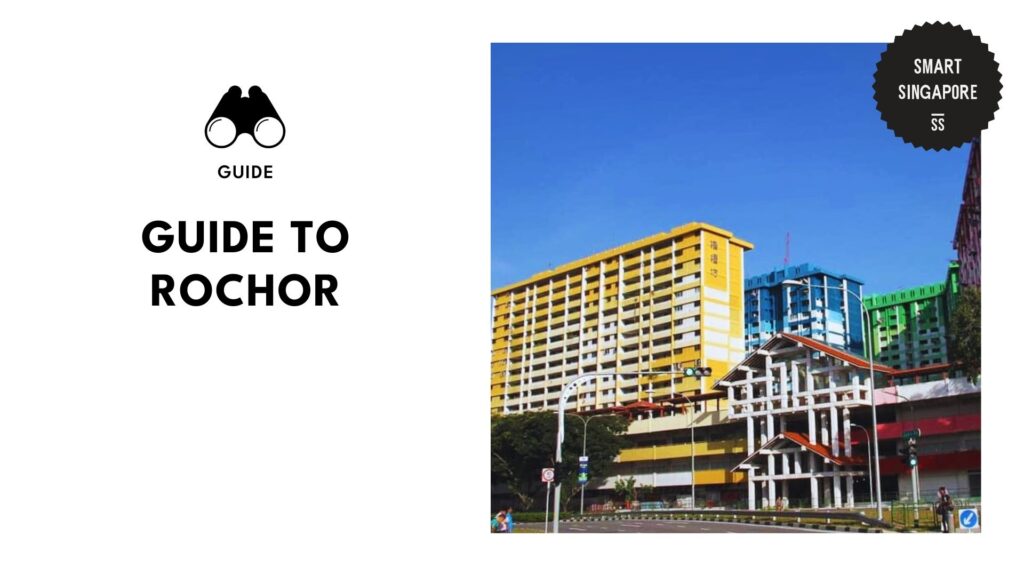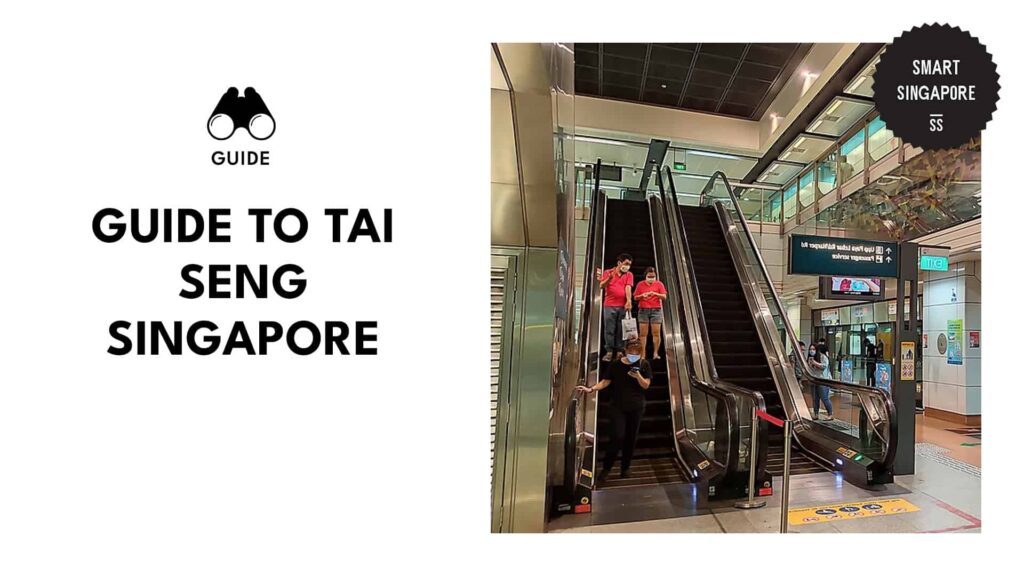Categories > Guides and Tips
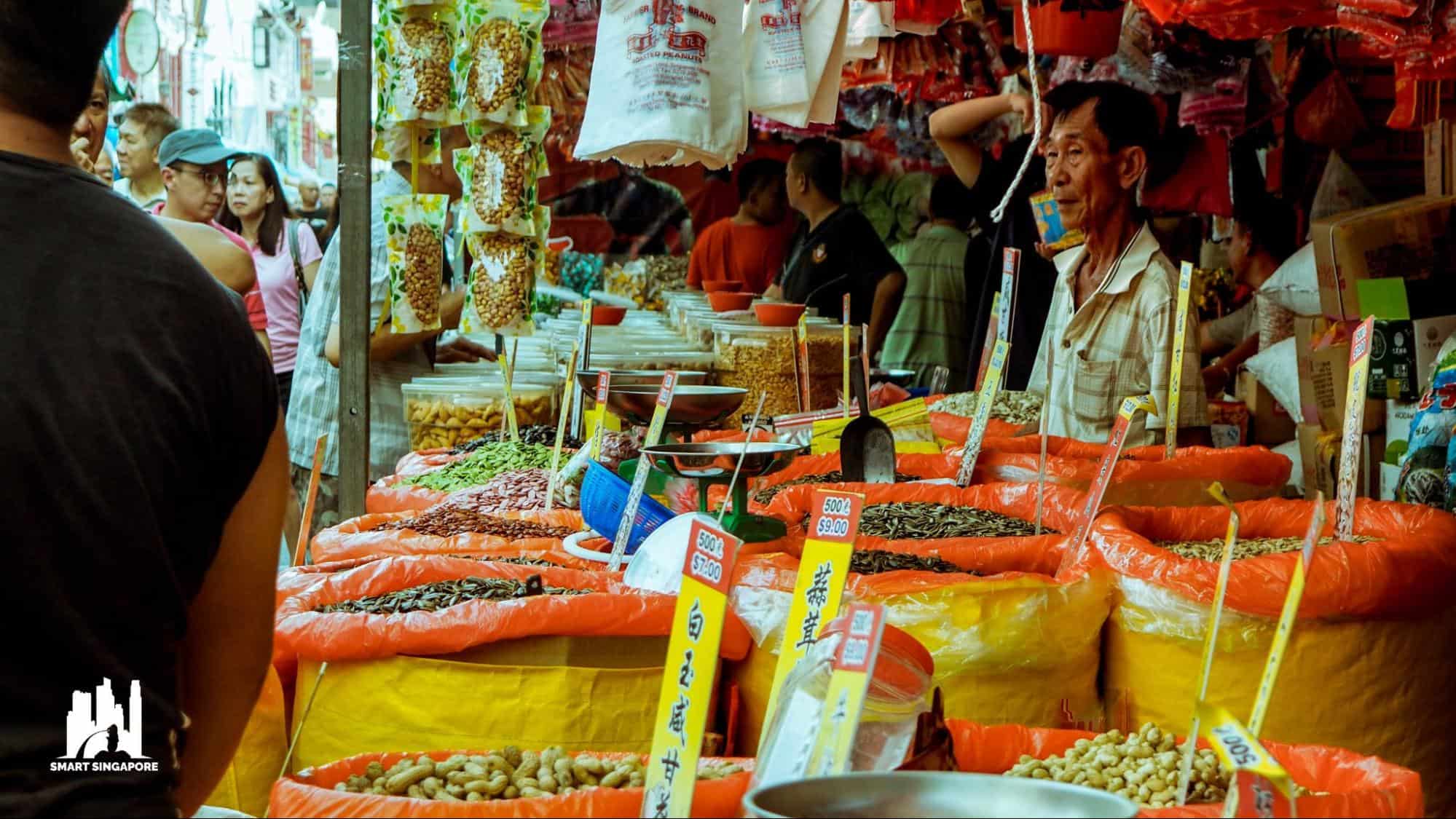
Top 8 Things to Do in Chinatown, Singapore
- Is Chinatown in Singapore worth visiting?
- Chinatown Visitor Centre
- Which part of Singapore is Chinatown?
- Top Things to Do in Chinatown, Singapore
- Admire Chinatown’s age-old, intricate temples
- Buddha Tooth Relic Temple & Museum
- Why is the Buddha Tooth Relic Temple important?
- Sri Mariamman Temple
- Why was the Sri Mariamman Hindu Temple built?
- Thian Hock Keng Temple
- Learn about Islam in the iconic Masjid Jamae
- When was Jamae Mosque built?
- Know more about Chinatown and Singapore’s history
- Chinatown Heritage Centre
- Singapore City Gallery
- Revel in the beauty of Chinatown’s captivating murals
- Detective Conan in Chinatown Mural
- Thian Hock Keng Temple Mural
- Mid-Autumn Festival Mural
- My Chinatown Home
- Cantonese Opera Mural
- Other Chinatown Murals to Check Out
- Take a whiff of Chinatown’s history from the estate’s oldest buildings
- Jinrikisha Station
- Maxwell Chambers
- Shake Shack
- Murray Terrace
- Shop til you drop at Chinatown’s shopping zones
- Chinatown Street Market
- Cio Chinatown Point
- Yue Hwa
- Chinatown Complex
- When was the Chinatown Complex built?
- Sip delightful local cocktails at Chinatown’s bars
- Native
- Gibson
- Indulge in Singapore’s exciting dining scene
- Where to Eat: Best Food Stalls and Restaurants in Chinatown, Singapore
- Maxwell Food Centre
- Tian Tian Hainanese Chicken Rice
- Jin Hua Fish Head Bee Hoon
- Fuzhou Oyster Cake
- Special Shanghai Tim Sum
- Telok Ayer Area
- Restaurant Aisyah
- Shukuu Izakaya
- Park Bench Deli
- Chinatown Complex Food Centre
- Lian He Ben Ji Claypot
- Zhong Guo La Mian Xiao Long Bao
- Xiu Ji Ikan Bilis Yong Tau Fu
- The 1950s Coffee
- Explore More: Other Chinatown Sites Worth Checking Out
- Singapore Musical Box Museum
- NUS Baba House
- Keong Saik Road
- What is Keong Saik Road famous for?
- Everton Park
- Pinnacle@Duxton Skybridge
- Where to Stay: Top Accommodations in Chinatown, Singapore
- Amoy Hotel
- KeSa House
- CUBE
- How to Get to Chinatown, Singapore
- How do I get a Singapore travel pass?
- Is the SG Tourist Pass worth it?
- How to Get around Chinatown, Singapore
Chinatown in Singapore is a must-visit when exploring the island country not only because travel guides tell you so. More importantly, we believe you’ll have a great time, whatever type of traveler you are.
Are you planning your itinerary? Let us help you with this ultimate guide to the things to do in this historic Singapore destination.
Is Chinatown in Singapore worth visiting?
Chinatown in Singapore is worth the visit, as you’ll have an eventful day exploring the tourist site, regardless if you love walking, eating, learning, or taking pictures.
Cultural heritage fans will get excited by the many exquisite temples, while foodies will have a field day with street food and local cuisine, most of which are budget-friendly!
Meanwhile, wanna-be Singapore connoisseurs will delight in the facts and goodies they’d learn and find in museums and specialized shops that line the streets.
Similarly, travelers who love to capture moments will love the precinct’s beautiful murals, colorful nightlife, and festive vibe.
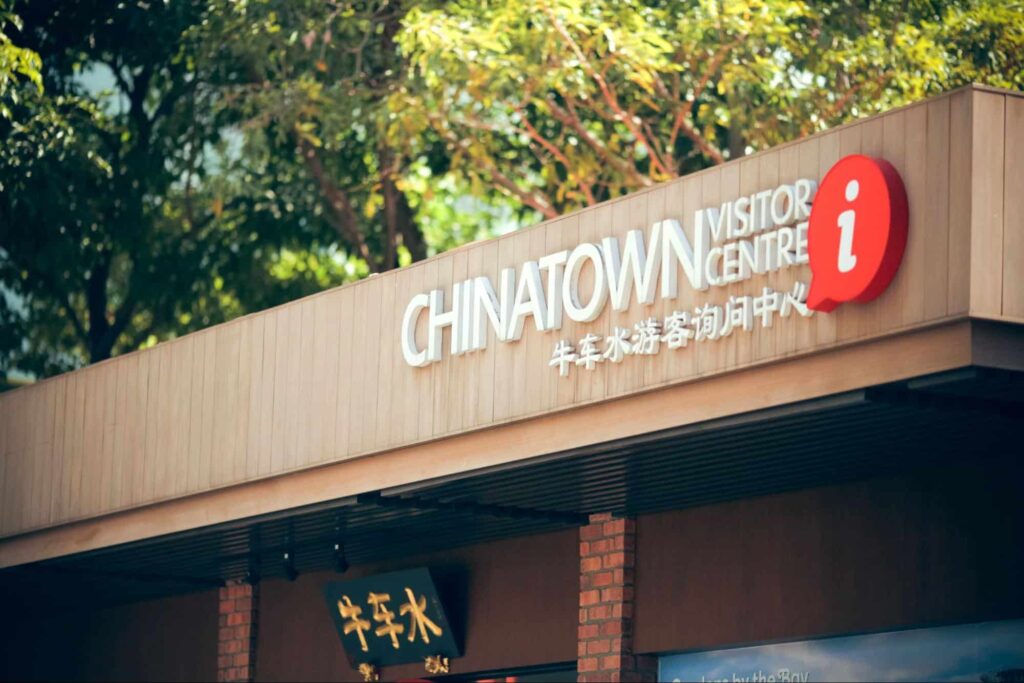
We recommend swinging by the Chinatown Visitor Centre to get helpful information about the estate, purchase tickets, and book accommodations.
Chinatown Visitor Centre
| Address | 2 Banda St, Singapore 059962 |
| Contact Details | +65 6534-8942 |
| Opening Hours | Daily: 9:00 AM – 6:00 PM |
Which part of Singapore is Chinatown?
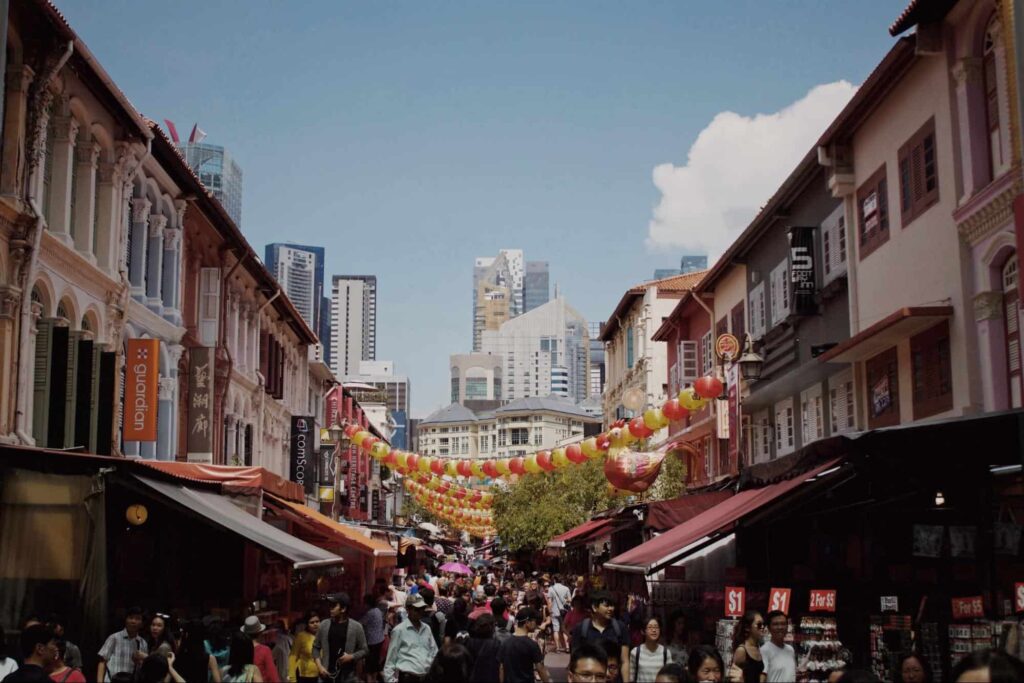
Chinatown in Singapore is an estate located in Outram, a planning area within the city center in the country’s Central Region.
The historic estate is west of the Singapore River, serving first as a community settlement for Chinese immigrants way back in the 1820s.
If you’re wondering where Central Region is, it is located south of Singapore Island and houses 21 planning areas.
Top Things to Do in Chinatown, Singapore
- Admire Chinatown’s age-old, intricate temples
- Learn about Islam in the iconic Masjid Jamae
- Know more about the history of Chinatown and Singapore
- Revel in the beauty of Chinatown’s captivating murals
- Take a whiff of Chinatown’s history from the estate’s oldest buildings
- Shop til you drop at Chinatown’s shopping zones
- Sip delightful local cocktails at Chinatown’s bars
- Indulge in Chinatown, Singapore’s exciting dining scene
Apart from these activities, go deeper into our guide for additional stops and exploration tips to make the most of your Chinatown visit!
- Explore More: Sites nearby Chinatown Worth Checking Out
- Where to Stay: Top Accommodations in Chinatown, Singapore
- How to Get to Chinatown, Singapore
- How to Get Around Chinatown, Singapore
1. Admire Chinatown’s age-old, intricate temples
Chinatown, Singapore is prestigious in part because of its enchanting historical temples. See the awe-inspiring structures up close and learn more about the major beliefs that gave rise to them.
Buddha Tooth Relic Temple & Museum
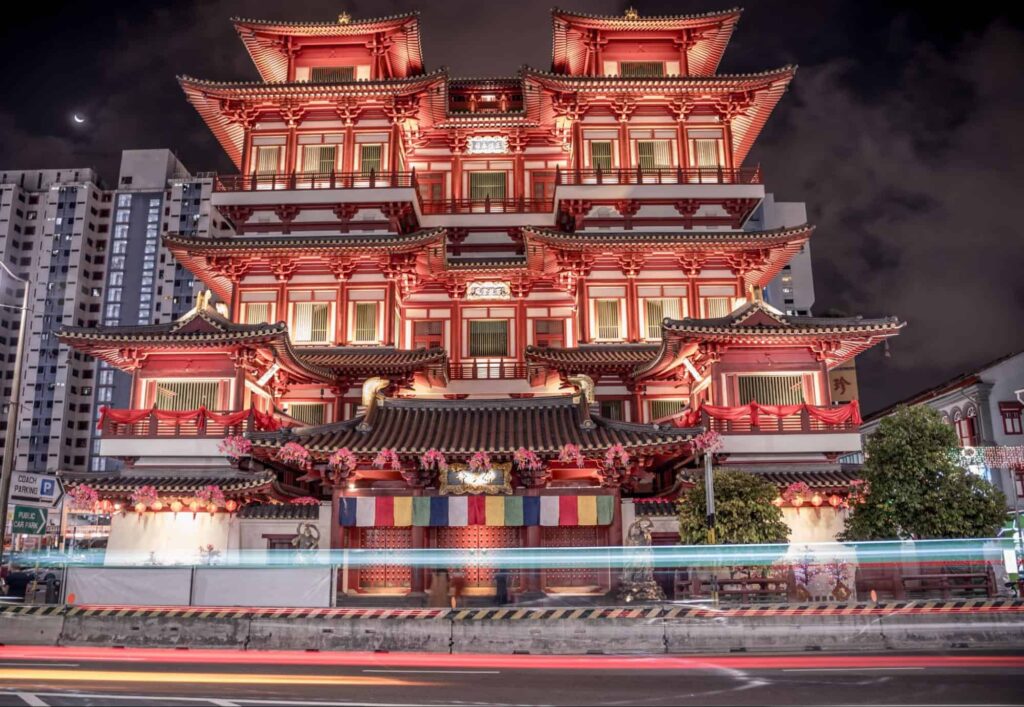
| Address | 288 South Bridge Rd, Singapore 058840 |
| Contact Details | +65 6220-0220 | services@btrts.org.sg |
| Opening Hours | Daily: 7:00 AM – 5:00 PM *The museum opens at 9:00 AM |
It’s hard to miss the Buddha Tooth Relic Temple & Museum thanks to its imposing bulk yet delicate lines and forms. And while it celebrates traditional Chinese architecture, it’s updated with modern facilities to cater to today’s guests.
Each temple level offers experiences that will delight the senses, starting from the ground level’s magnificent Hundred Dragons Hall with its high ceiling and the towering Buddha Maitreya Statue.
You can find the temple’s museum on the third level and the believed tooth relic inside a glittering stupa on the fourth level. Furthermore, lovely pavilions and a pagoda await you on the temple’s roof.
Why is the Buddha Tooth Relic Temple important?
The Buddha Tooth Relic Temple & Museum is held in high regard for being one of the many religious and cultural institutions in Chinatown, Singapore.
The structure also promotes Buddhist culture in the area and serves as a venue for people practicing the religion.
Moreover, the temple’s architecture is a genuine eye-catcher and is a prime attraction to tourists both local and foreign.
Sri Mariamman Temple
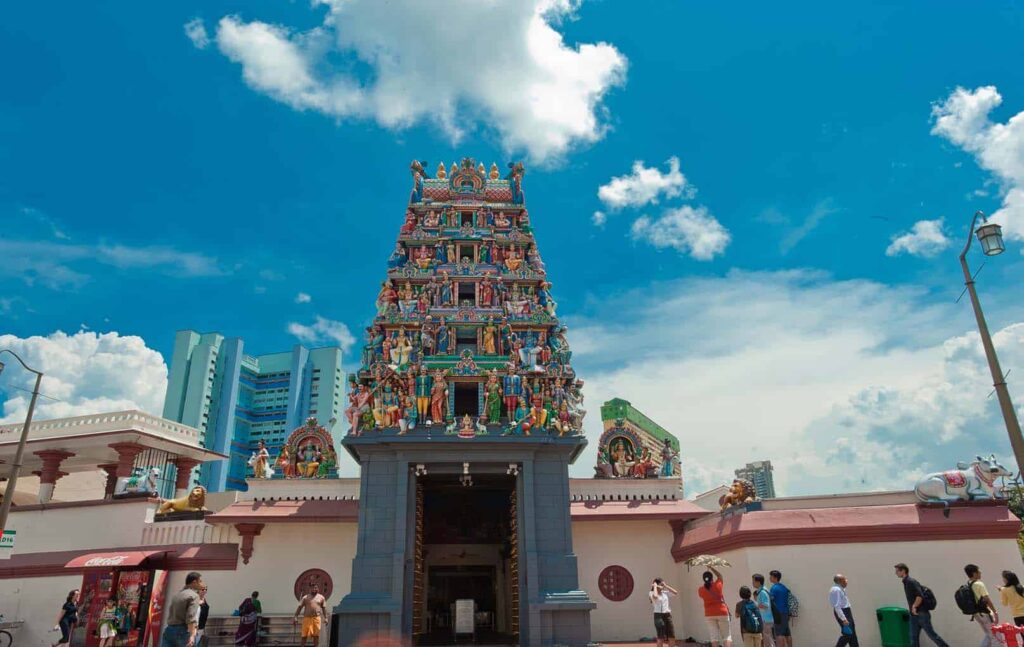
| Address | 244 South Bridge Rd, Singapore 058793 |
| Contact Details | +65 6223-4064 | smt@heb.org.sg |
| Opening Hours | Daily: 5:30 AM – 11:30 AM, 6:00 PM – 8:45 PM |
Sri Mariamman’s entrance tower (called gopuram) is an unforgettable sight for its dense, ornate sculptural depiction of Hindu mythology and culture. And that’s only the facade—more statues and decorations await you inside the worship site.
Aside from being an architectural wonder, this temple also hosts Hindu rituals, prayer services, and festivals. The main one is the Theemithi (Fire Walking Ceremony) celebrated every October or November.
The structure is constructed in 1827 and is the oldest Hindu temple in Singapore.
Why was the Sri Mariamman Hindu Temple built?
The Sri Mariamman Temple was built for use of Indian immigrants to worship the Mariamman, the Hindu rain goddess. The deity is largely venerated in South India.
The structure’s construction was credited to Indian pioneer Naraina Pillai, Singapore’s first building contractor. Sri Mariamman Temple was pronounced a national monument on June 28, 1973.
Thian Hock Keng Temple
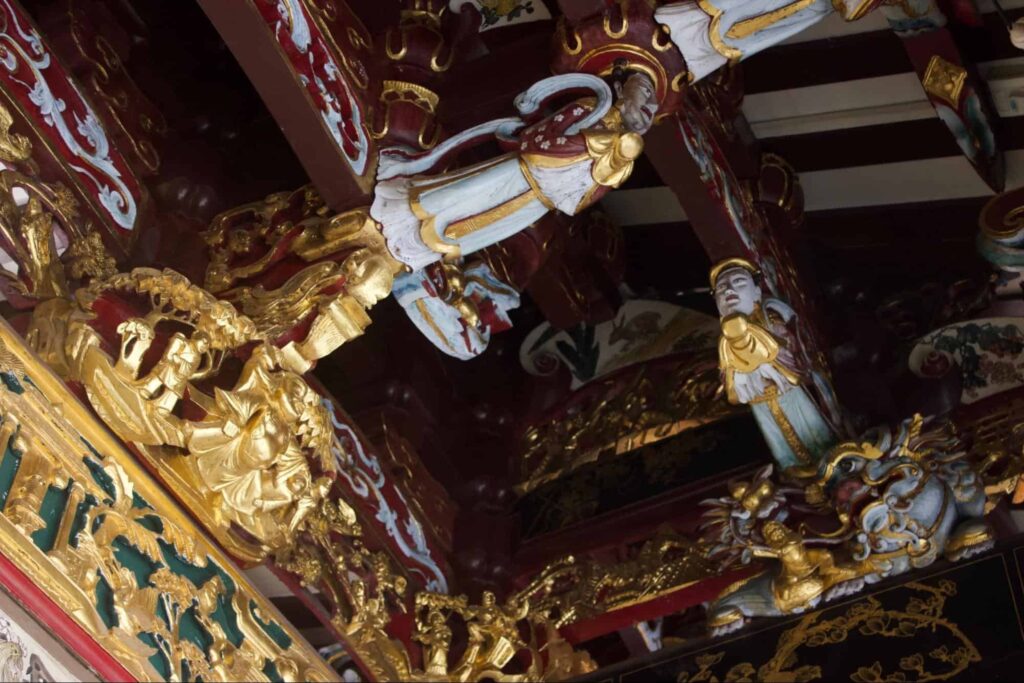
| Address | 158 Telok Ayer St, Singapore 068613 |
| Contact Details | +65 6423-4616 | admin@shhk.com.sg |
| Opening Hours | Daily: 7:30 AM – 5:30 PM |
We half-expect you to let out a silent cry of awe once you see the Thian Hock Keng Temple up close. And we would understand; after all, this structure is a striking masterpiece worth the accolades and praise.
From its roof decorations to textured wooden beams to elaborate interiors, everything about Thian Hock Keng is an architectural triumph. What’s most amazing is that the builders didn’t use a single nail for its construction (viva Chinese architecture!).
Thanks to Singapore’s impressive conservation efforts, the temple has hoarded awards including an Honorable Mention from the prestigious UNESCO Asia-Pacific Heritage Awards in 2001.
2. Learn about Islam in the iconic Masjid Jamae
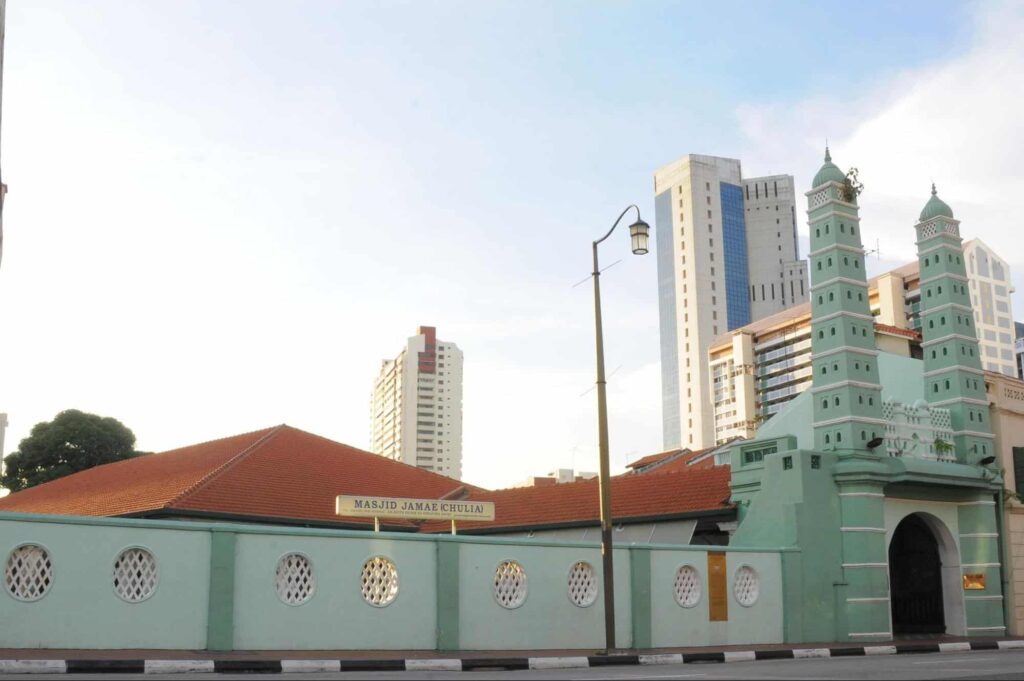
| Address | 218 South Bridge Rd, Singapore 058767 |
| Contact Details | +65 6221-4165 | masijidjamae@singnet.com.sg |
| Opening Hours | Daily: 2:00 PM – 6:00 PM |
Standing proud along a street that is predominantly Chinese is the eclectic Masjid Jamae (or Jamae Mosque).
The Muslim religious monument reflects both eastern and western influences. You’ll see distinctive Indo-Islamic minarets co-existing with neoclassical Doric columns making up the structure’s features.
You can learn more about Islam by attending the temple’s classes on Qur’an and Islamic studies. They usually hold the sessions during the weekends.
When was Jamae Mosque built?
The Masjid Jamae or Jamae Mosque was built between 1830 and 1835. The Chulias, Tamil Muslims from South India, were credited with its construction.
3. Know more about Chinatown and Singapore’s history
Gain insights about Chinatown and Singapore by checking out these educational centers!
Chinatown Heritage Centre
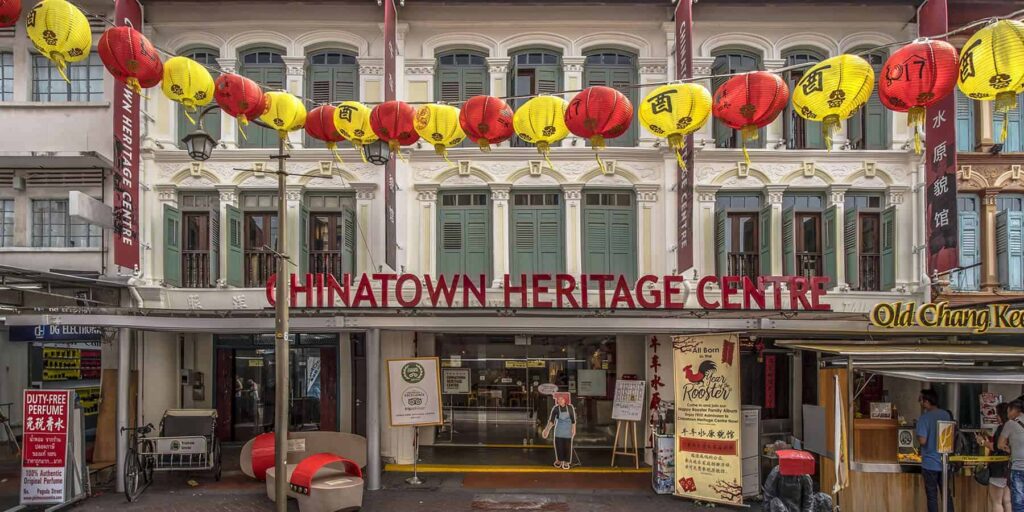
| Address | 48 Pagoda St, Singapore 059207 |
| Contact Details | +65 6224-3928 | enquiry@chinatownhc.com.sg |
| Opening Hours | Daily: 9:30 AM – 6:00 PM *Temporarily closed as of writing for renovation and operating model review |
| Rates | Children: $14 Adults: $14 Senior citizen (accompanied by a paying visitor): Free entry |
The Chinatown Heritage Centre holds exciting exhibits showing what life was like in early Chinatown. Recreation of living quarters used in the 1950s and narratives of Chinese immigrant stories enrich a visitor’s trip down memory lane.
Moreover, interactive exhibits such as craft workshops, olfactory displays, and larger-than-life photography props create an immersive experience that is both educational and entertaining.
Once the heritage center reopens to the public, we can only hope that it gets so much better and more engaging.
Singapore City Gallery
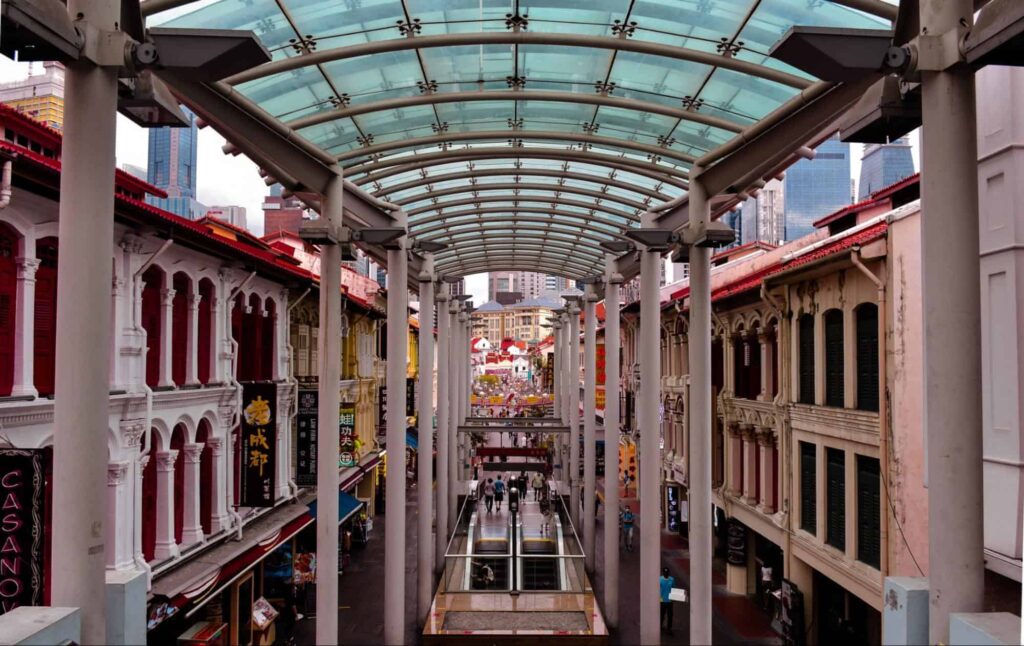
| Address | 45 Maxwell Rd, The URA Centre, Singapore 069118 |
| Contact Details | +65 6221-6666 |
| Opening Hours | Monday to Saturday: 9:00 AM – 5:00 PM |
| Rates | Free entry |
If you’re curious about how Singapore became one of the most livable cities in Asia, the Singapore City Gallery houses exhibits that will show you how they achieved the feat.
Expect high-quality photos of structures old and current, detailed maps of the Central Area and all of Singapore, and an immersive show featuring the city’s ingenious urban systems.
Those who love looking at scale models are in for a treat with the gallery’s Central Area Model.
The display is not a run-of-the-mill model too. It’s one of the largest of its kind and is continuously updated to reflect the changing cityscape!
4. Revel in the beauty of Chinatown’s captivating murals
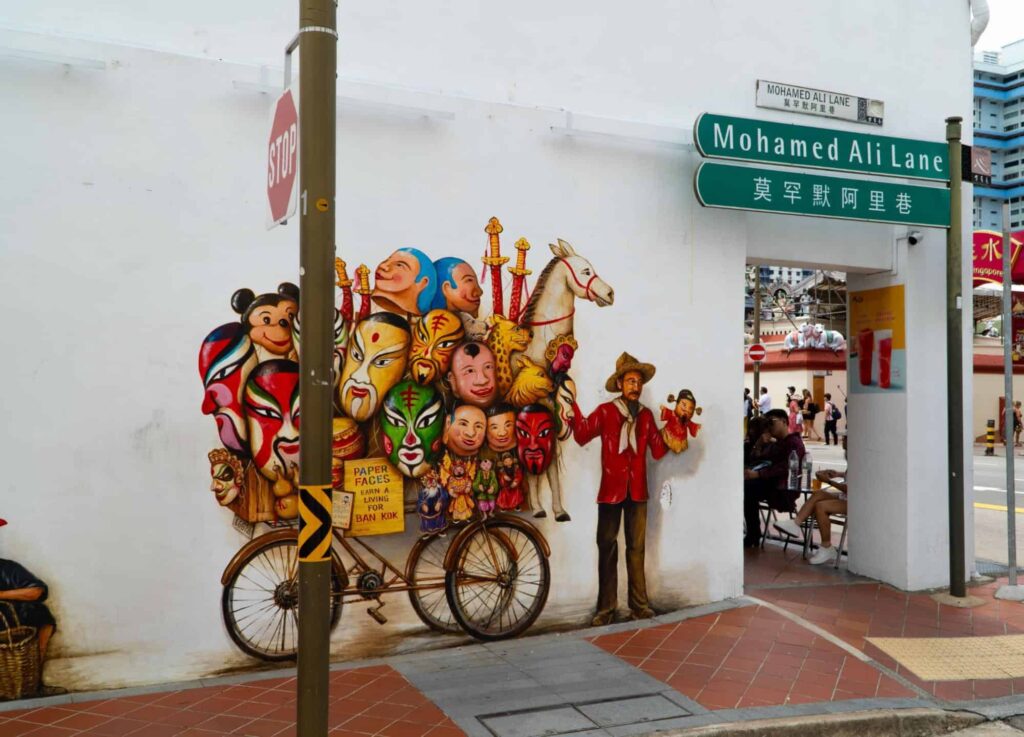
As if the majestic temples and bustling shops aren’t enough, Chinatown in Singapore raises its bar higher with its spectacular public art. Here are our favorites!
- Detective Conan in Chinatown Mural
- Thian Hock Keng Temple Mural
- Mid-Autumn Festival Mural
- My Chinatown Home
- Cantonese Opera Mural
Detective Conan in Chinatown Mural
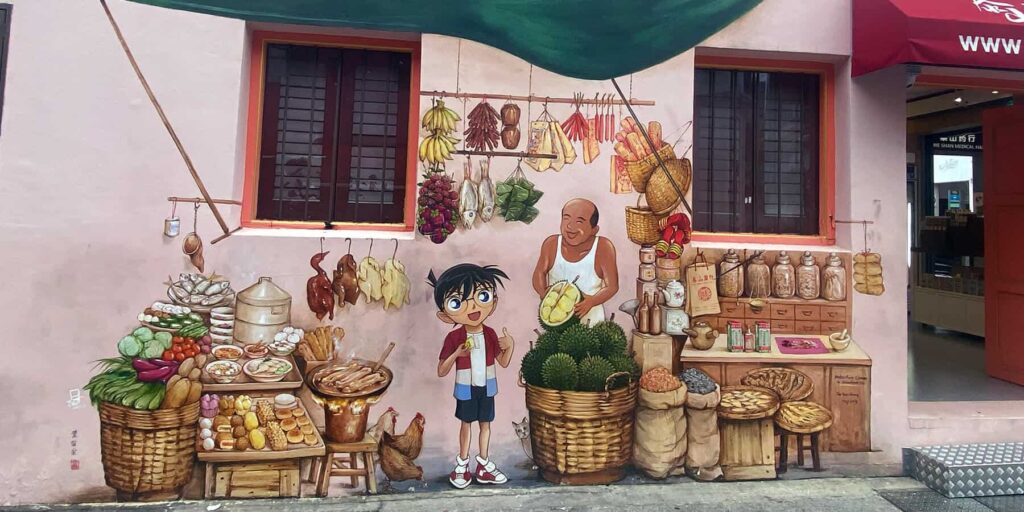
| Address | Smith St, Singapore 058953 |
Conan Edogawa and a basket of durians in one picture seem weird at first, but we’re sure you’ll love seeing it in person. The beloved manga character is even depicted liking the fruit (for all its mixed reviews)!
The mural works well with the pastel-colored wall and captures Chinatown’s stalls in all their bountiful and eclectic glory.
Thian Hock Keng Temple Mural
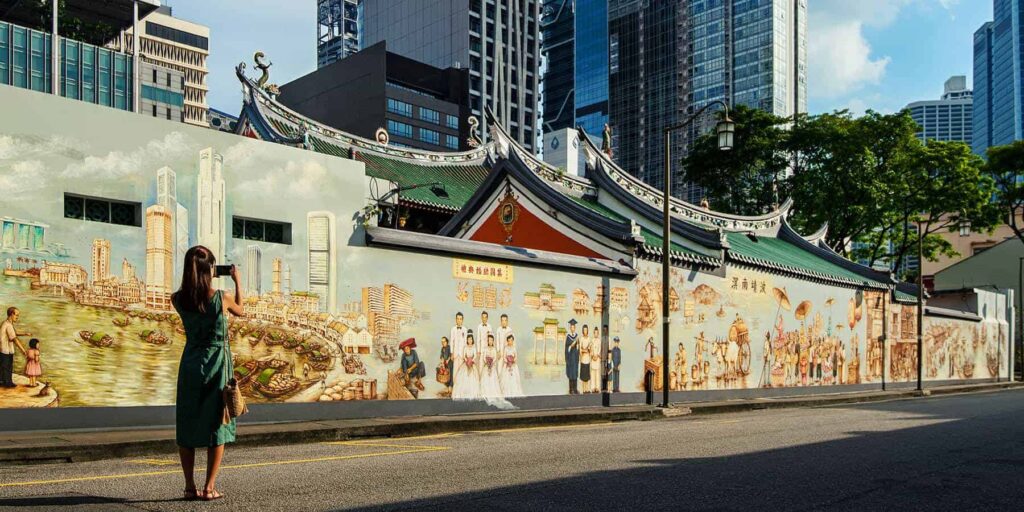
| Address | 158 Telok Ayer St, Singapore 068613 |
There’s more to the award-winning Thian Hock Keng Temple than you expect, thanks to the structure’s back wall which contains a stunning mural by Yip Yew Chong.
The wall art stretches for 40 meters and depicts the lives of Singapore’s early Chinese immigrants, specifically the dialect group Hokkien. These early settlers are celebrated for their contribution to shaping the current city.
Mid-Autumn Festival Mural
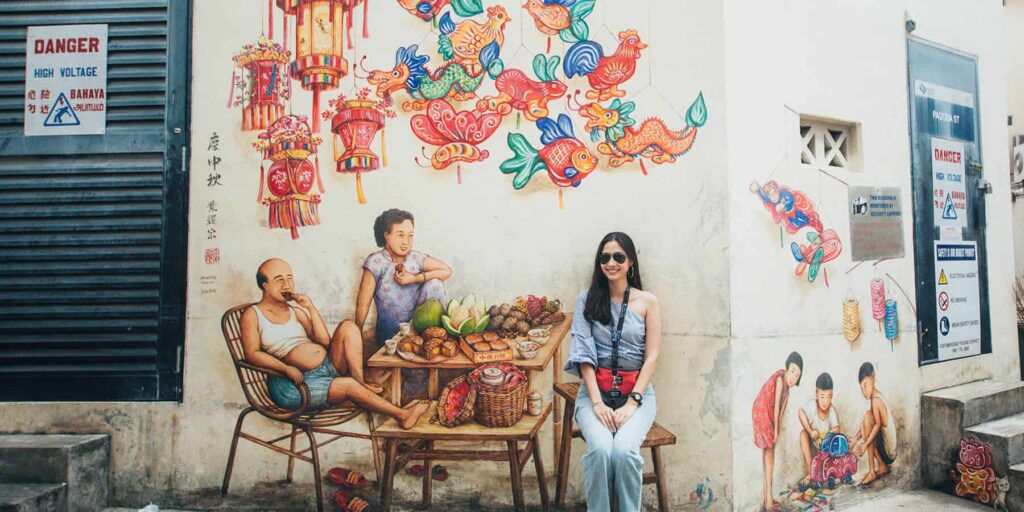
| Address | 83 Pagoda St, Singapore 059432 |
A humble wall behind an alley in Chinatown depicts a scene of the Mid-Autumn Festival that you’d love to “join.”
The art shows two figures seated around a table, enjoying pomelo and mooncakes while looking on at children playing nearby. You can join the scene by “sitting” on an empty chair across the table.
The art pops with the vibrant colors of the lanterns and zodiac animals decorating the upper part of the wall, making for eye-catching photos worthy of your travel feed.
My Chinatown Home
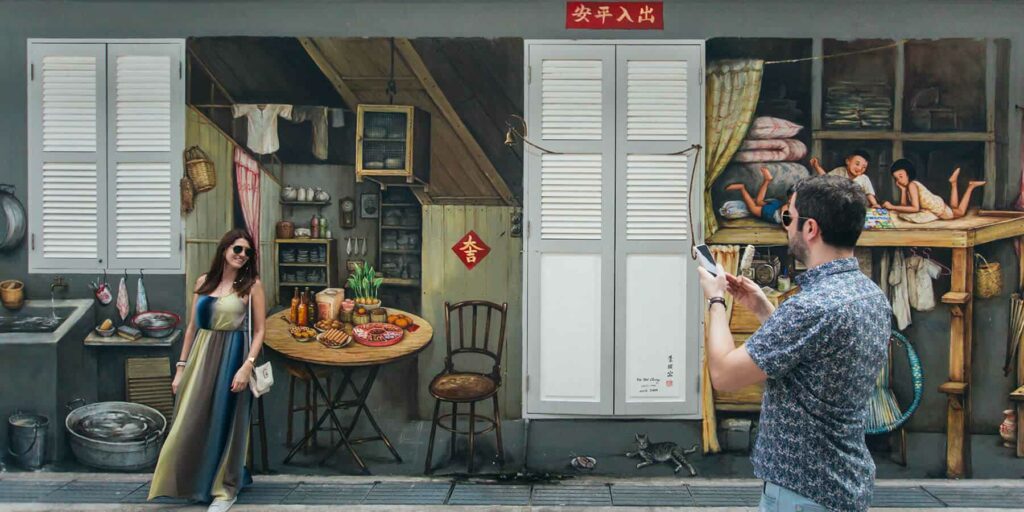
| Address | 30 Smith St, Singapore 058944 |
The nostalgia-inducing My Chinatown Home allows you to take a peek at the homey interiors of a Chinatown shophouse without entering one!
The mural scene depicts old homeware, simple furniture, a woman mending clothes, and children engrossed in board games.
The colors aren’t as vibrant as other festive murals, but the wall art remains captivating for its rich details and genius use of light and shadows.
Cantonese Opera Mural
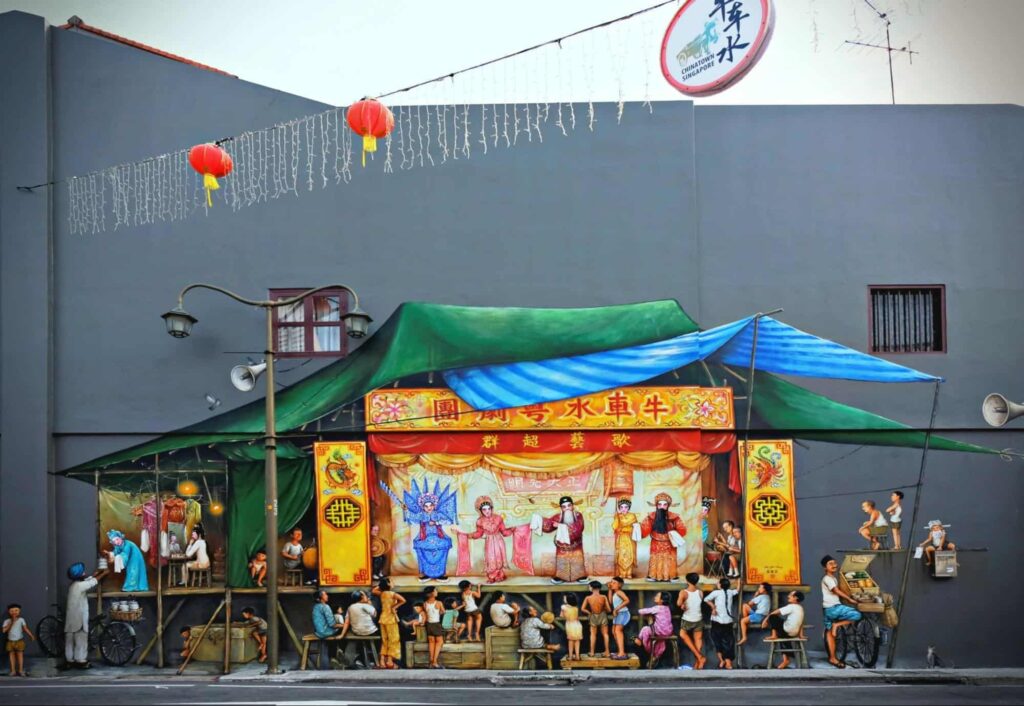
| Address | 5 Temple St, Singapore 058556 |
This mural ingeniously combines the concept of Chinese opera as a popular form of street entertainment in the past and the nature of murals as public art.
The work comes alive with the depicted performers’ flamboyant costumes and the evident enthrallment of the audience.
The decision to paint the work over a gray concrete wall helped convey how bright and eye-catching these street performances were.
Other Chinatown Murals to Check Out
Aside from our picks, we recommend checking out Chinatown’s other Instagram-worthy street art.
Go down Smith Street to admire the Bruce Lee Mural and Letter Writer Mural, take a picture of the intricate Dragon Mural at Gemmill Lane, or admire the beautiful Floral Mural at Keong Saik Road.
5. Take a whiff of Chinatown’s history from the estate’s oldest buildings
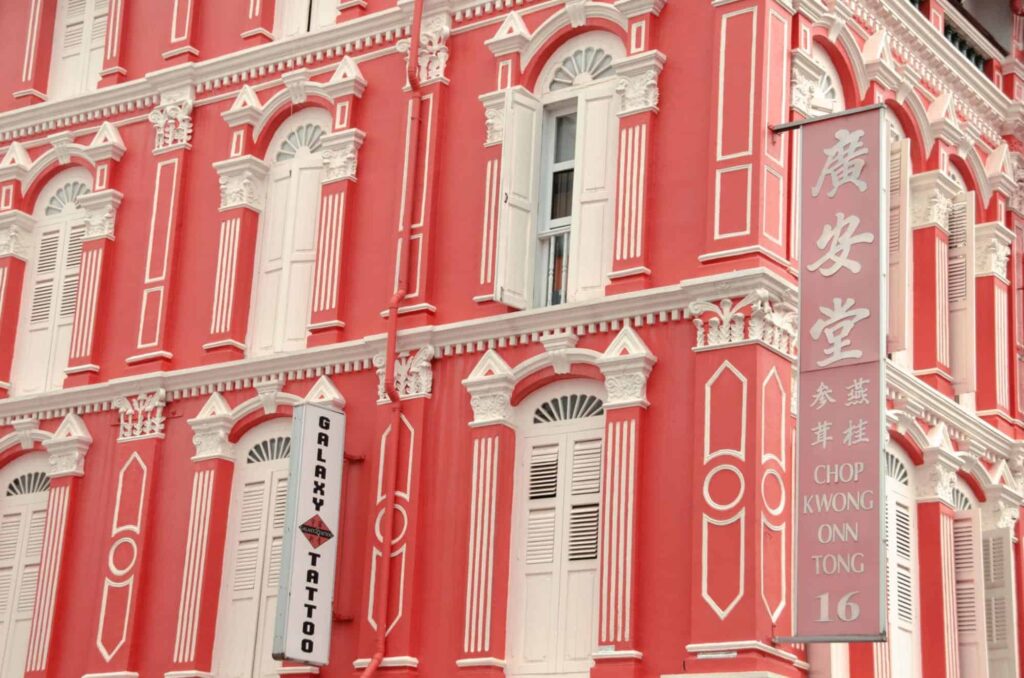
Aside from temples and mosques, Chinatown in Singapore is dotted with buildings that carry a long history. Snap a photo or enter the structure and experience a bit of these age-old structures!
Jinrikisha Station
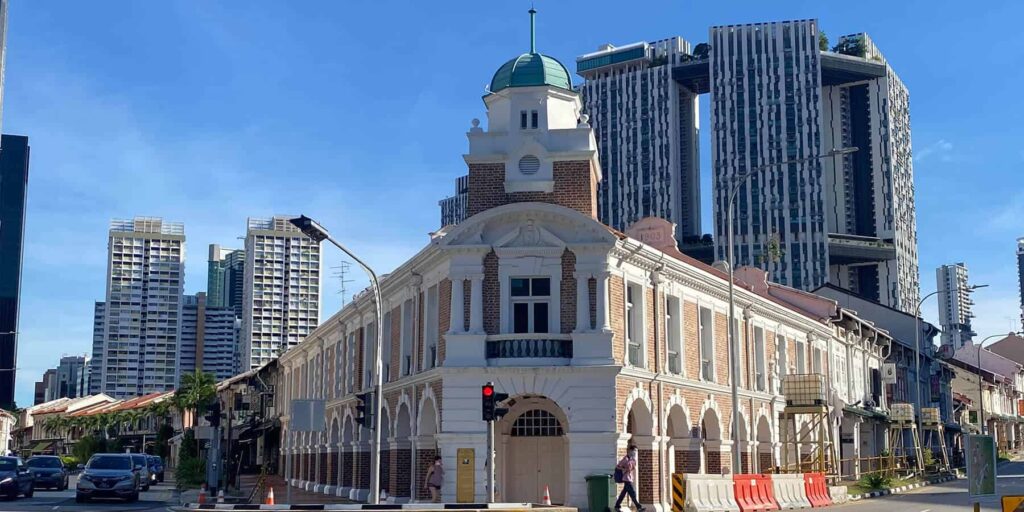
| Address | 1 Neil Rd, Singapore 088804 |
The Jinrikisha Station served as a central depot for rickshaws in 1903. “Jinrikisha” is the Japanese term for the said mode of transport.
The most striking features of the structure are its red bricks (that have beautifully aged through time), its octagonal cupola, and its curved pediment.
The building’s overall character is also reminiscent of the Edwardian style, which was used in the 1900s across the British empire.
Maxwell Chambers
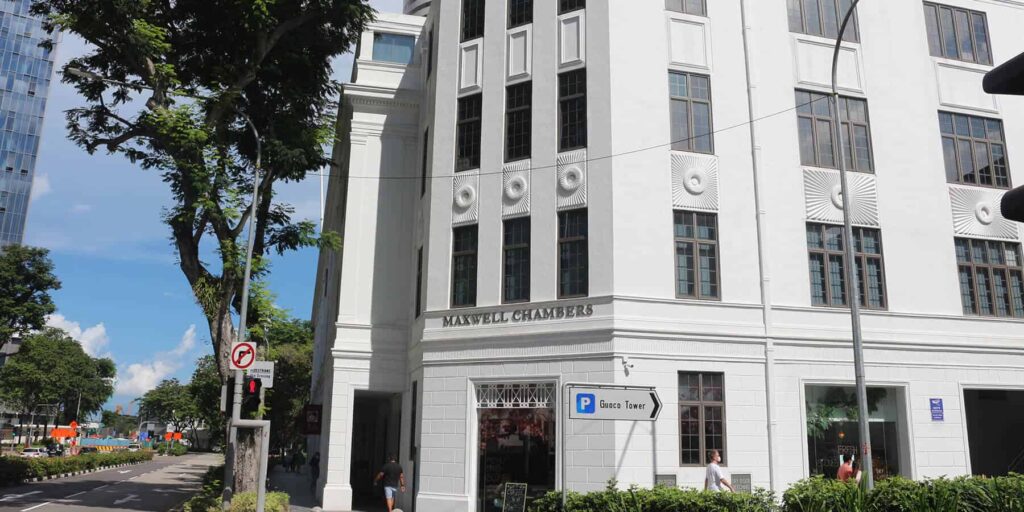
| Address | 32 Maxwell Rd, Singapore 069115 |
Its straight lines, symmetrical features, and dignified character make the Maxwell Chambers an iconic public structure, not to mention that its white paint finish gives it an almost ethereal glow.
It was built in 1932 and housed the Department of Customs and Excise, Film Censor’s Office, and Maxwell Road Post Office.
Today, Maxwell Chambers (or the White House as many Singaporeans call it) serves as a commercial building.
Shake Shack

| Address | 89 Neil Rd, Singapore 088849 |
You’re probably wondering why a burger joint is included in our list of historical buildings. Well, know that this gorgeous building first served as a factory when it was first erected in the 1920s.
Formerly called Eng Aun Tong (Hall of Everlasting Peace), the structure was used to manufacture Singapore’s Tiger Balm for 50 years.
Notable features of the building include its flat roof (which was rare before World War II) and its six-sided pavilion perched on the top.
We’re so thankful Shake Shack was content to affix a minimalist logo on the building’s facade and hang a few signs, preserving the simplicity yet elegance of this architectural work.
Murray Terrace
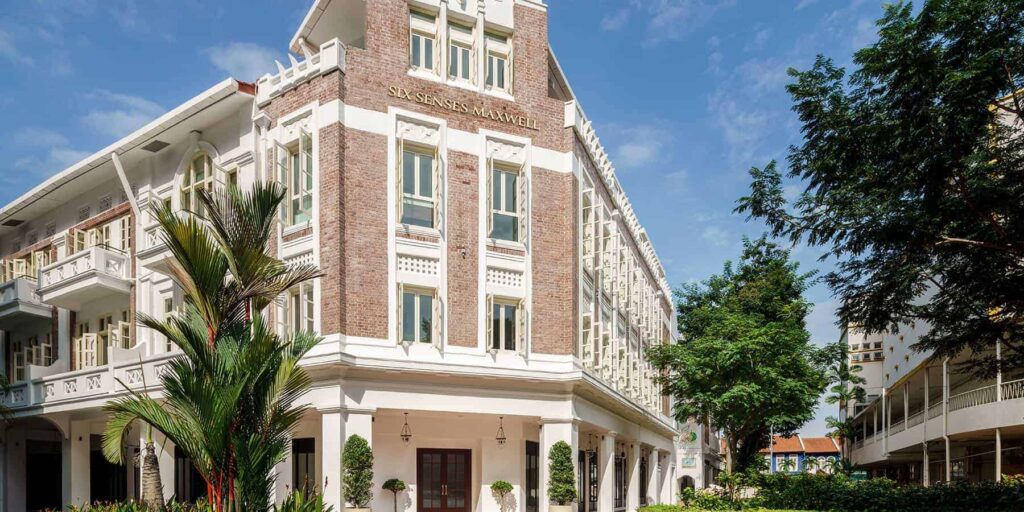
| Address | 2 – 28 Murray St, Singapore 079519 |
The Murray Terrace almost didn’t make it to the 21st century if not for the Urban Redevelopment Authority’s decision to rehabilitate the structure. We sure appreciate the choice they made, as the 1929 structure is one real looker.
Its exposed red bricks are the first to catch your attention. But if you look closer, you’d love the building’s lion rain spouts, claw-like protrusions on the sides, octagonal columns, and intricate ventilation panels.
Maybe it’s the architectural nerd in us who is speaking right now, but we recommend seeing the details yourself and experiencing Singapore’s impressive conservation works firsthand.
6. Shop til you drop at Chinatown’s shopping zones
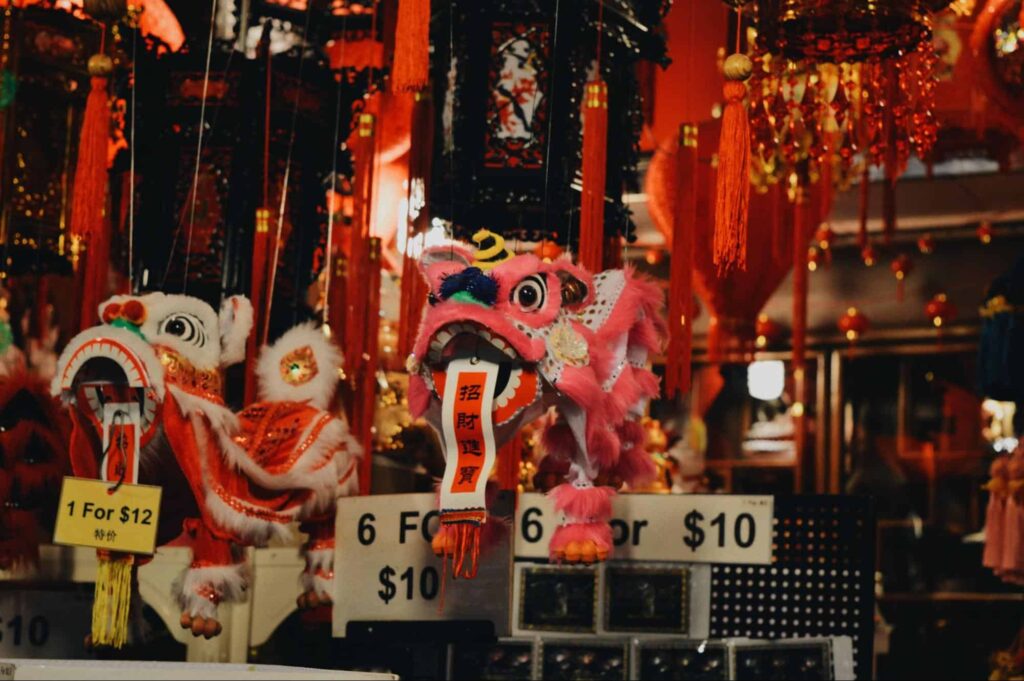
Shopaholics will be spoilt for choice when they walk down Chinatown’s roads for the wide selection of Chinese goods, rare antiques, souvenirs, and everyday items.
If you’re diligent, we suggest scouring the shopping areas, as many gems are awaiting the persistent shoppers!
Chinatown Street Market
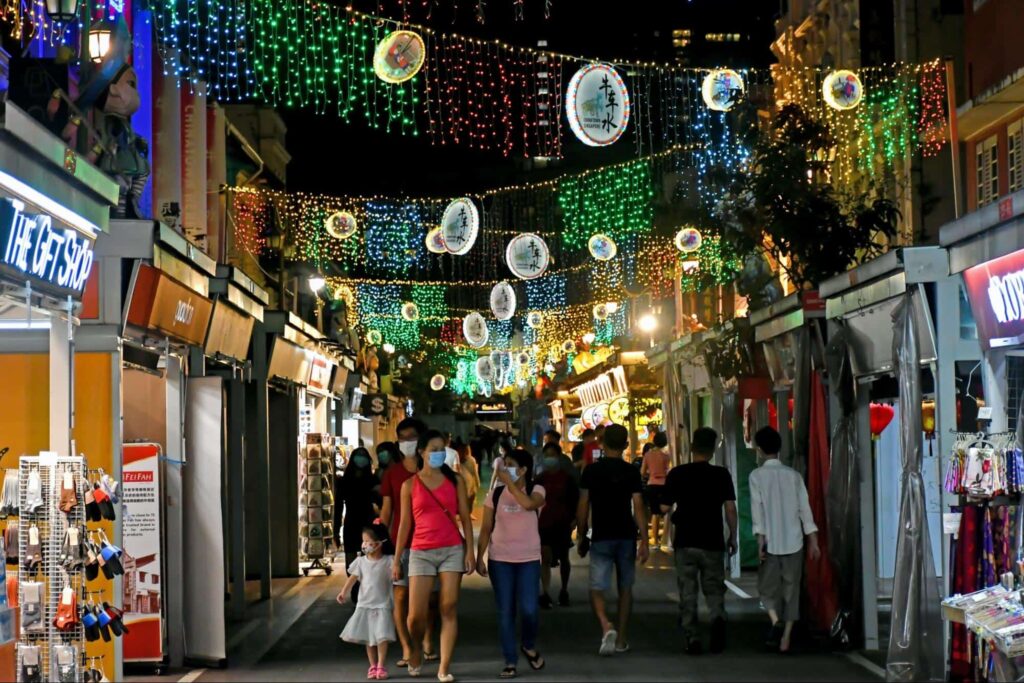
| Address | Pagoda St & Trengganu St, Singapore 050005 |
| Opening Hours | Daily: 9:30 AM – 8:00 PM |
Shopping is never boring when you walk down the Chinatown Street Market. Stalls fill both sides of the road, selling almost everything you can imagine from robes to lucky cats to Chinese opera masks.
Moreover, the streets are lined with food carts. We all know how tasty Singapore’s street food is, so prepare your budget and tummy for multiple servings of your favorites.
The liveliest part of shopping here is the haggling part. Prepare your best Singlish (or Chinese if you’re bold) and attempt scoring items for the lowest prices possible.
While you can totally shop during the daytime, the market becomes extra festive at dusk as the lanterns light up.
Cio Chinatown Point
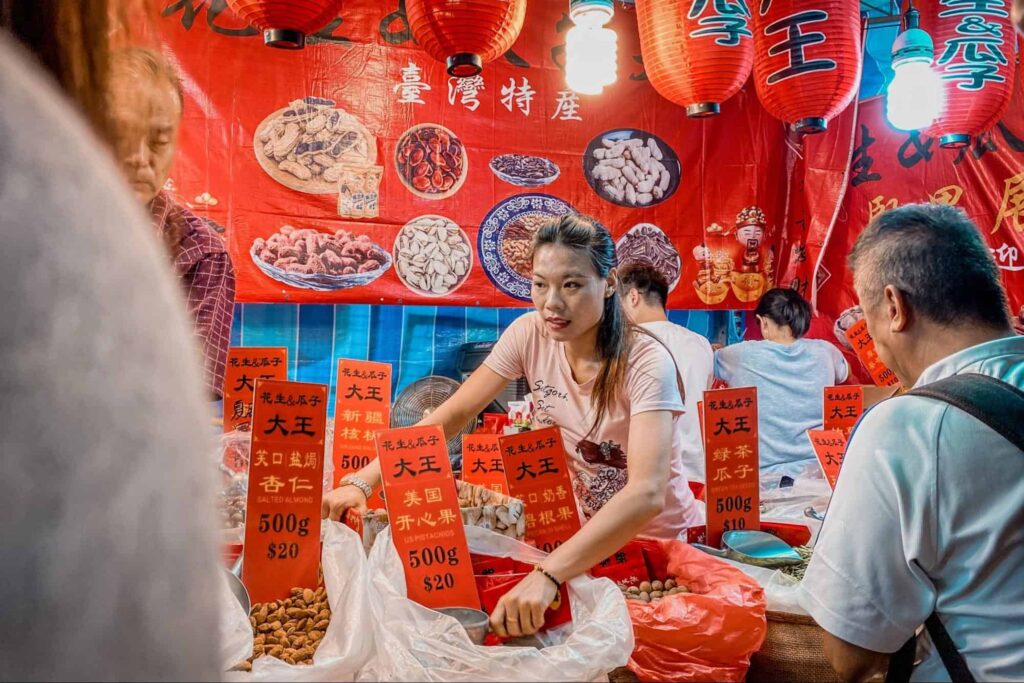
| Address | 133 New Bridge Rd, Singapore 059413 |
| Opening Hours | Daily: 10:00 AM – 10:00 PM |
Cio Chinatown Point is the next best option if you prefer the usual shopping mall experience. The good news is that a lot of items here are more affordable.
The six levels have over 200 shops selling fashion and accessories, fresh produce, grocery items, jewelry, and many more. There are also restaurants on-site in case you go hungry while looking around.
Cio’s art and craft stores are also notable for their wide range of goods, including rare finds and ancient works.
Yue Hwa
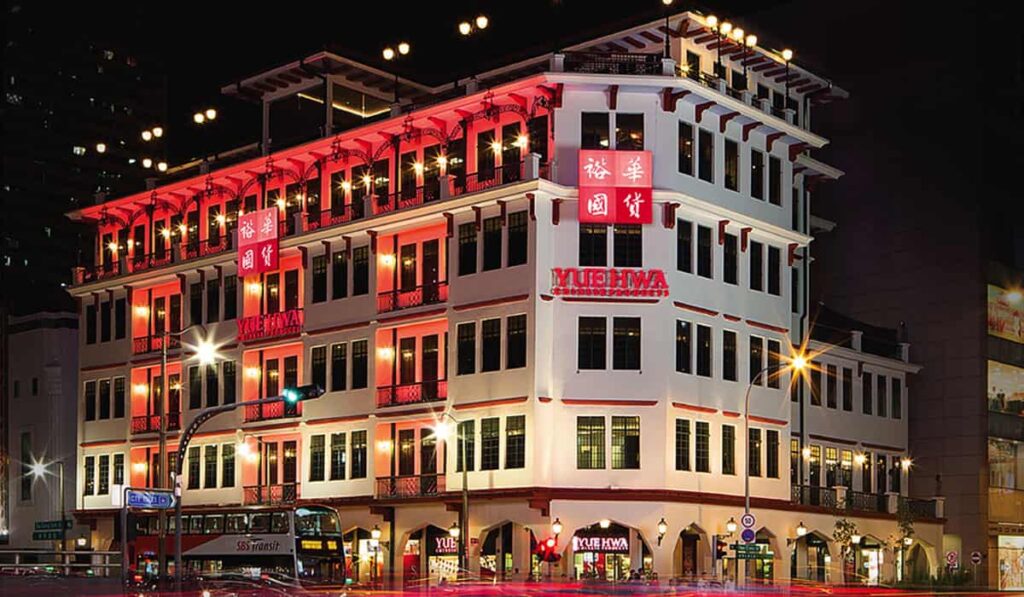
| Address | 70 Eu Tong Sen St, Singapore 059805 |
| Opening Hours | Daily: 11:00 AM – 9:00 PM |
Yue Hwa is home to high-quality Chinese products that you’ll be proud to bring with you home as souvenir presents for your loved ones.
The Chinese teas, seasonings, sauces, wine, noodles, and pickled goodies here are to die for, and the prices aren’t that high.
And while we’ve been talking mostly about food, rest assured that Yue Hwa also sells paintings, game items, fashion goods, and even abacuses!
It’s nice that the shopping center also holds candle-making workshops and painting classes. Do check out if you can join any of them and feel more like a local!
Chinatown Complex

| Address | 335 Smith St, Singapore 050335 |
| Opening Hours | Daily: 8:00 AM – 12:00 AM |
The Chinatown Complex houses a market, a food center (which we’ll talk about later), and plenty of small shops, making it one of the largest modern shopping stops in the area.
It’s important that the complex is a massive building with wide thoroughfares, as it is home to about 700 hawkers.
Apart from the promise of diverse shopping finds, the Chinatown Complex is a building that shoppers will appreciate. After all, it’s designed to be inclusive and conducive to recreational activities.
User comfort is prioritized with the spacious plaza, a shaded lane with seating, a roof garden, a play area, and aerated and well-lit interiors. On-site parking is also available.
When was the Chinatown Complex built?
Construction of the Chinatown Complex began in 1975 and the building was finally erected in 1981. It didn’t officially open for business until 1983.
The building is part of government efforts for Chinatown’s urban renewal, specifically to address overcrowding and poor living conditions in the area.
In 1983, 300 street hawkers were resettled to the complex and paved the way for the clearing of the district’s sidewalks and drain system.
7. Sip delightful local cocktails at Chinatown’s bars
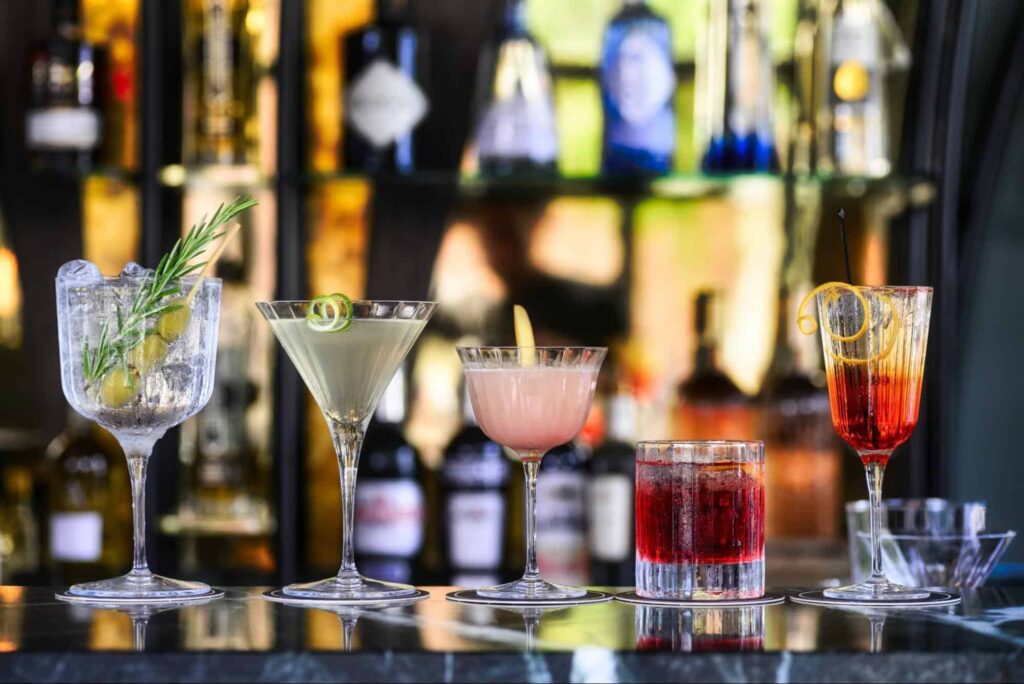
Chinatown in Singapore is not all about the shops and food carts. Unwinding and socializing over a tipple is also possible, thanks to the district’s prime bars.
Native

| Address | 52A Amoy St, Singapore 069878 |
| Contact Details | +65 8869-6520 | info@tribenative.com |
| Opening Hours | Monday to Saturday: 6:00 PM – 12:00 AM |
| Menu | Beer: $15 – $17 Fizzies: $25 Cocktails: $25 Spirits: $19 – $23 Wine: $17 Moringa fries: $13 Petai-so clams: $27 Chicken pao fan: $32 Desserts: $16 |
Nothing screams “local” as Native Bar’s selection of drinks. The beer, cocktails, and everything on their menu make use of regional products and ingredients, plus they come in local names!
Moreover, the wares, scents, and even the bar’s ambient music are truly Singaporean.
The best part is that the bar observes sustainable production and practices, well-fitting for an establishment located in one of the world’s most livable cities.
Gibson
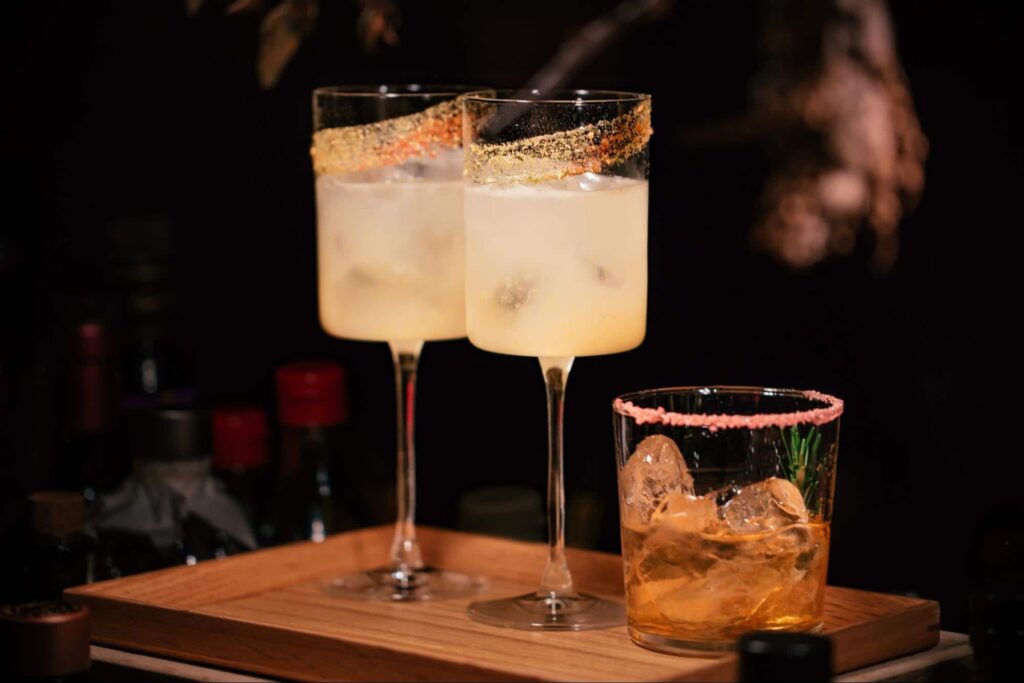
| Address | 20 Bukit Pasoh Rd, Singapore 089834 |
| Contact Details | +65 9114-8385 | info@gibsonbar.sg |
| Opening Hours | Monday, Wednesday to Thursday, Sunday: 6:00 PM – 12:00 AM Friday to Saturday: 6:00 PM – 2:00 AM |
| Menu | Cocktails: $25 Reserve cocktails: $30 – $32 Spirits: $20 – $90 Snacks: $12 – $30 Big plates: $19 – $72 Desserts: $14 – $16 |
Those looking for unconventional cocktails will delight in Gibson’s creations. The bar’s concept cocktails are inspired by the mythical creature Chimera, so expect fusions that are innovative and unforgettable.
The bar makes use of local products and ingredients while incorporating classic cocktail structures in creating its drinks menu. Of course, the Japanese-inspired Gibson martini staple remains, and you definitely should experience it at least once.
8. Indulge in Singapore’s exciting dining scene
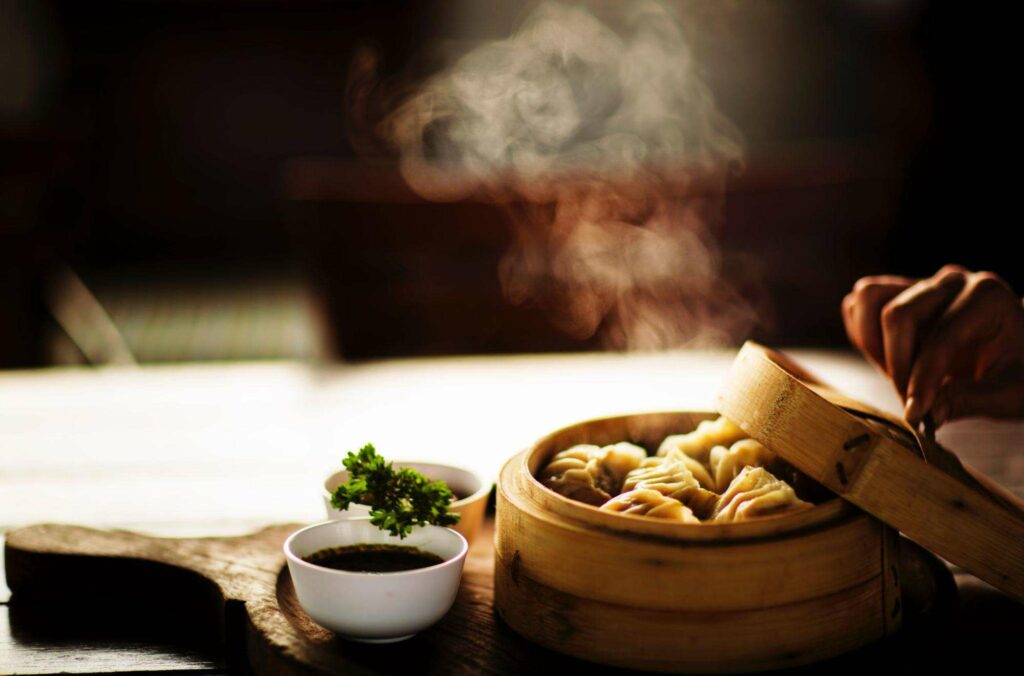
Our last item on our Chinatown to-do list but definitely not the least is going out there and sampling the array of food up for grabs around the district.
To make your food hunt much easier, we picked hawker stalls and restaurants from famous dining zones.
Take note that the moment you enter the dining zones, you’d be overwhelmed by the sizzle and aroma around you that you might end up wanting to try it all.
But since eating all that is in front of you is virtually impossible, we recommend making a list of places that you most wanted to dine in and sticking to that.
Where to Eat: Best Food Stalls and Restaurants in Chinatown, Singapore
Maxwell Food Centre
The Maxwell Food Centre is home to over 100 hawker stalls offering budget-friendly, mouth-watering dishes including favorites chicken rice and dim sum. Here are some of the best stalls to check out!
Tian Tian Hainanese Chicken Rice

| Address | 1 Kadayanallur St, Maxwell Food Centre #01-10/11, Singapore 069184 |
| Opening Hours | Tuesday to Sunday: 10:00 AM – 8:00 PM |
| Price | About $5 per plate |
Tian Tian Hainanese Chicken Rice stall received a Michelin Bib Gourmand recommendation for its flavorful chicken and addictive rice. Servings come in small, medium, and large sizes to accommodate various appetites.
Watch out for the long queue during lunch, though.
Jin Hua Fish Head Bee Hoon
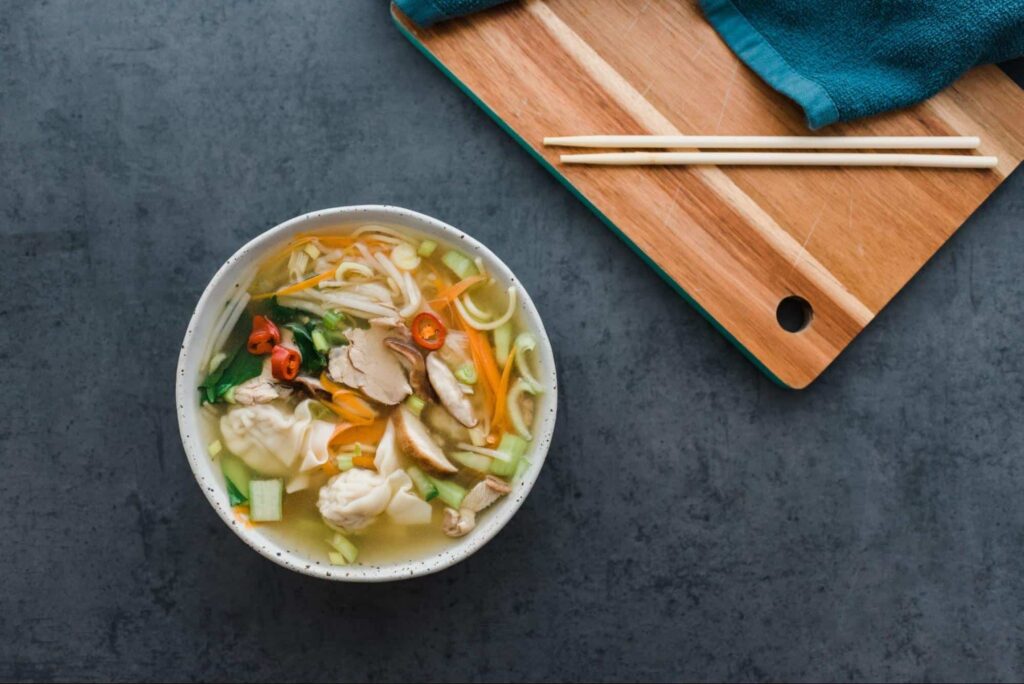
| Address | 1 Kadayanallur St, Maxwell Food Centre #01-77, Singapore 069184 |
| Opening Hours | Monday to Wednesday, Friday to Sunday: 11:30 AM – 8:30 PM |
| Price | Starts at $4.50 |
Jin Hua has been serving rich Cantonese-style fish soup for over 20 years now, making it an all-time favorite for locals and a must-try stall for tourists in Chinatown.
The stall’s soup is definitely addictive and comforting, plus the bee hoon can appease a hungry stomach. Long lines form easily during mealtimes, though, so try to visit them during non-peak hours.
Fuzhou Oyster Cake
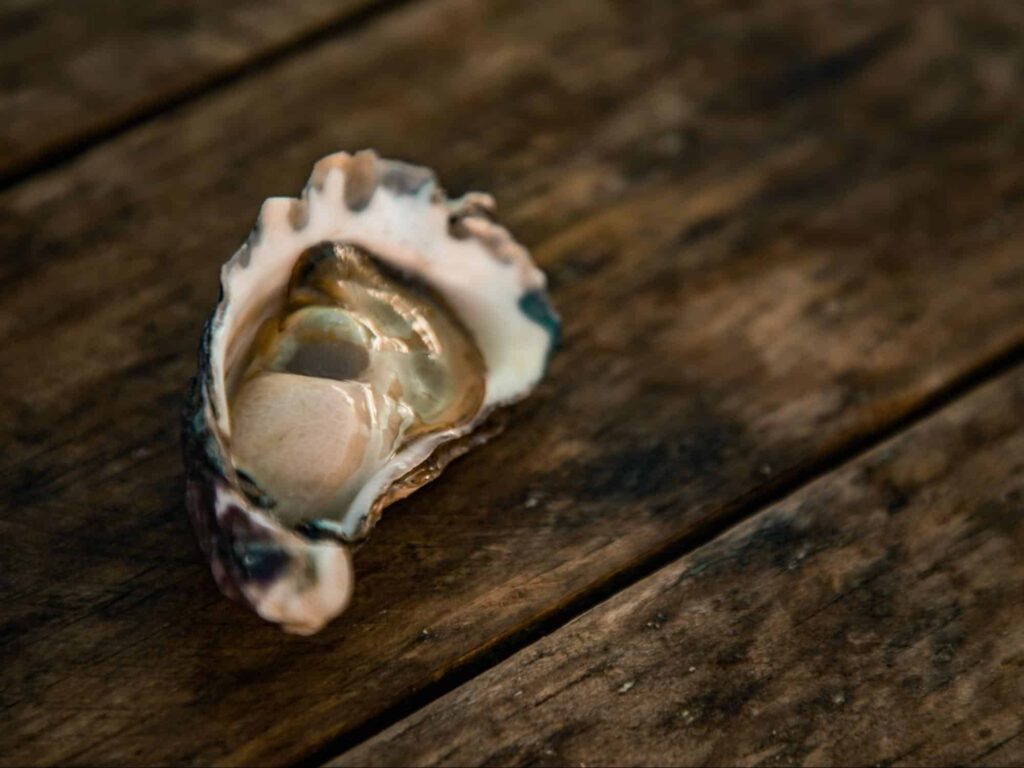
| Address | 1 Kadayanallur St, Maxwell Food Centre #01-05, Singapore 069184 |
| Opening Hours | Monday to Saturday: 9:00 AM – 8:00 PM |
| Price | Starts at $2 |
Fuzhou’s easy-to-eat oyster cake rewards the senses with its crispy wrapping and soft, hot filling.
While it’s called “oyster cake,” you’ll be treated to more than just oysters, as the dish is chock-full of ingredients, from minced meat to prawns to cilantro. Each serving is best enjoyed with chili sauce too!
The stall is one of the only few shops selling these fritters, so make sure to check them out as soon as you can.
Special Shanghai Tim Sum

| Address | 1 Kadayanallur St, Maxwell Food Centre #01-92, Singapore 069184 |
| Opening Hours | Tuesday to Sunday: 11:00 AM – 8:00 PM |
| Price | Starts at $4 |
Special Shanghai Tim Sum is known for its phenomenal dumplings (steamed and fried), Beijing noodles, and Shanghai rice cakes.
The dumplings are the ones you should not miss out on (and you might have to queue for), as the servings are made daily by hand with only the freshest ingredients!
Telok Ayer Area
The hip Telok Ayer neighborhood has an attractive selection of restaurants serving international cuisine and great coffee. The dining spots are also designed to satisfy foodies who are particular about ambience and style.
Restaurant Aisyah
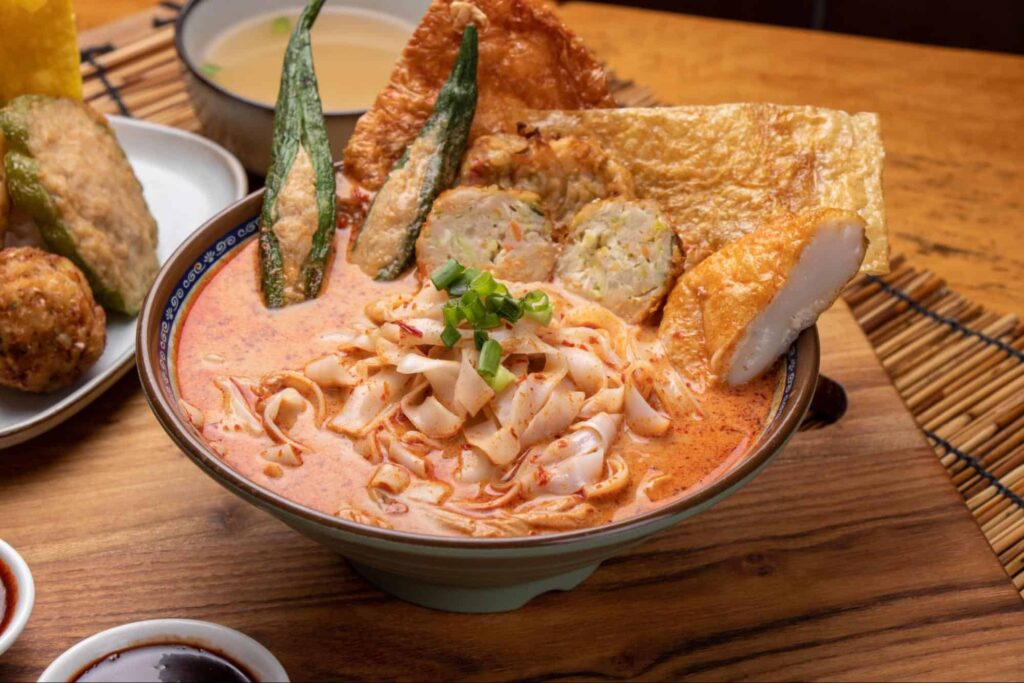
| Address | 176 Telok Ayer St, Singapore 068624 |
| Contact Details | +65 9374-4321 |
| Opening Hours | Monday, Wednesday to Thursday: 11:30 AM – 2:30 PM, 5:30 AM – 9:00 PM Friday to Sunday: 11:30 AM – 9:00 PM |
| Menu | Rice dishes: $10.80 – $14.80 Noodles: $10.80 – $13.80 Mains: $15 – $25 |
Restaurant Aisyah serves filling Chinese dishes that both Muslims and non-Muslims can enjoy.
Hearty bowls of hand-pulled noodles topped with chicken and mutton are sure to make hungry guests’ mouths water. And the rice dishes, especially the fried rice, will keep you wanting more.
The restaurant’s location is also perfect. It’s adjacent to the Thian Hock Keng Temple, meaning you can continue your immersive Chinese conquest from architecture to food in one fell swoop.
Shukuu Izakaya

| Address | 8 Stanley St, Singapore 068727 |
| Contact Details | +65 6327-9240 |
| Opening Hours | Daily: 5:30 PM – 10:30 PM |
| Menu | Sake (glass): $8 – $10 Sake (180ml): $30 – $42 Sake (360ml): $58 – $78 Starters: $6 – $10 Sashimi: $12 – $20 Kushiyaki: $4 – $16 Donburi: $11 – $14 |
The Shukuu Izakaya sake bar has everything, from the Japanese-style ambience to excellent waiting staff to pretty plated dishes that you’d hesitate eating for a second.
The servings are a bit pricey, but the dining spot makes up for it with its notable food selection. We recommend the restaurant’s heavenly skewers and fresh sashimi for light meals, perfect while you drink sake with friends.
Park Bench Deli
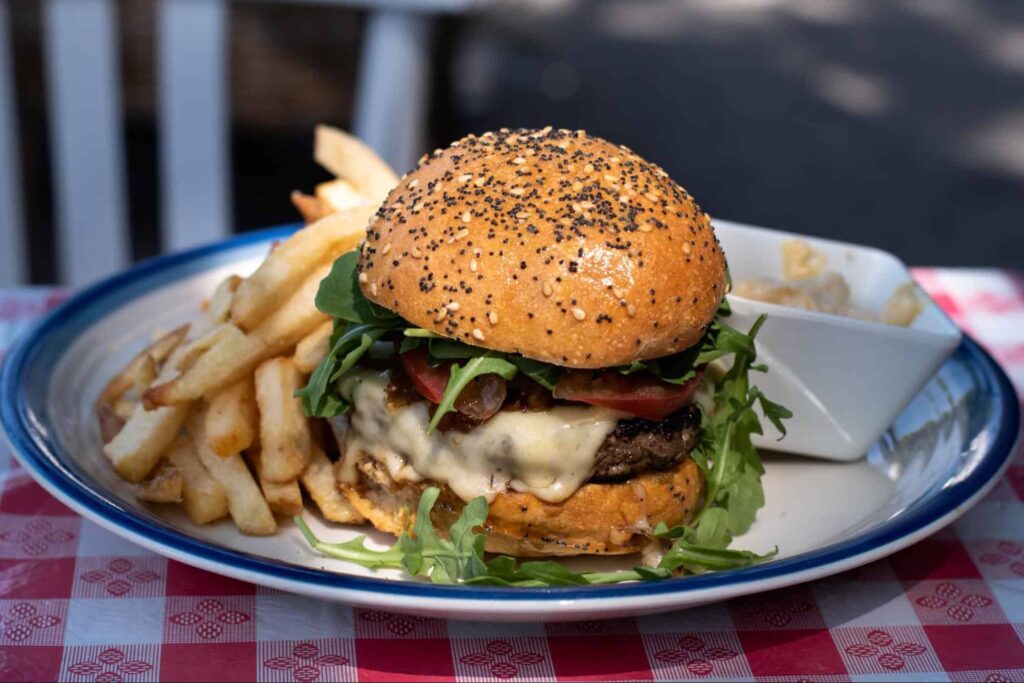
| Address | 179 Telok Ayer St, Singapore 068727 |
| Contact Details | +65 6815-4600 | hello@parkbenchdeli.com |
| Opening Hours | Monday to Friday: 7:30 AM – 4:00 PM, 5:00 PM – 9:00 PM Saturday to Sunday: 9:00 AM – 3:00 PM |
| Menu | Sandwich: $18 – $26 Salads: $16 Weekend brunch: $15 – $25 Coffee: $5 – $7 |
Park Bench Deli is American-inspired, which is a good thing for big eaters. Servings are hearty, the coffee is tasty, and the community vibe of the place makes meals more satisfying.
Try their weekend brunch menu to get a full taste of their motto: “do it big and do it right.”
Chinatown Complex Food Centre
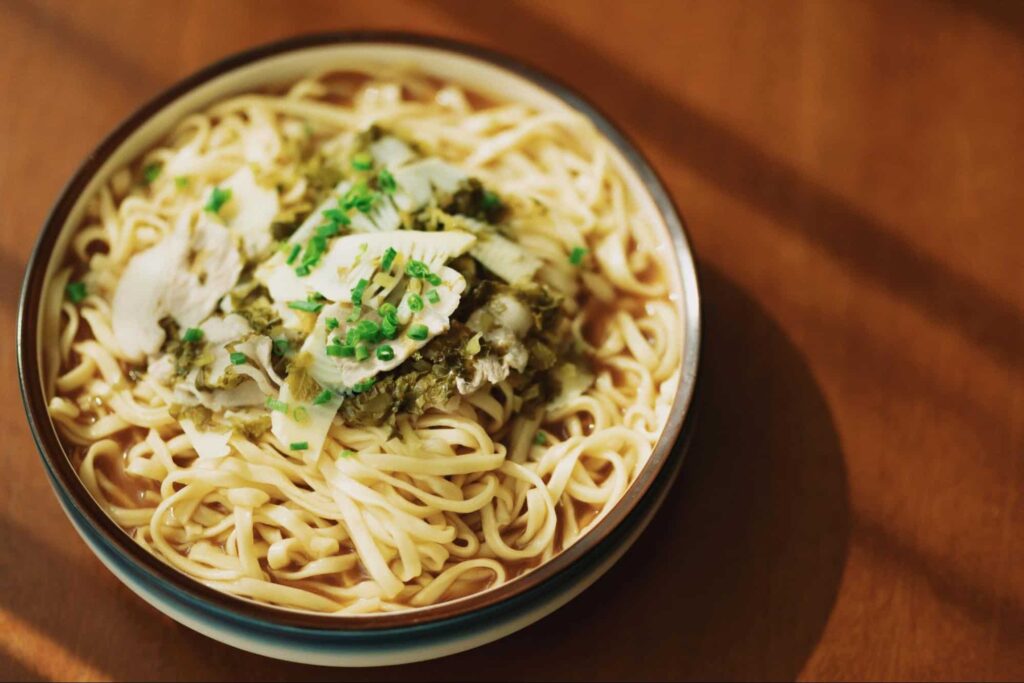
Over 200 hawker stalls fill the Chinatown Complex Food Centre, offering you a myriad of choices from sweet to savory to spicy dishes. We give you our top stalls to check out.
Lian He Ben Ji Claypot
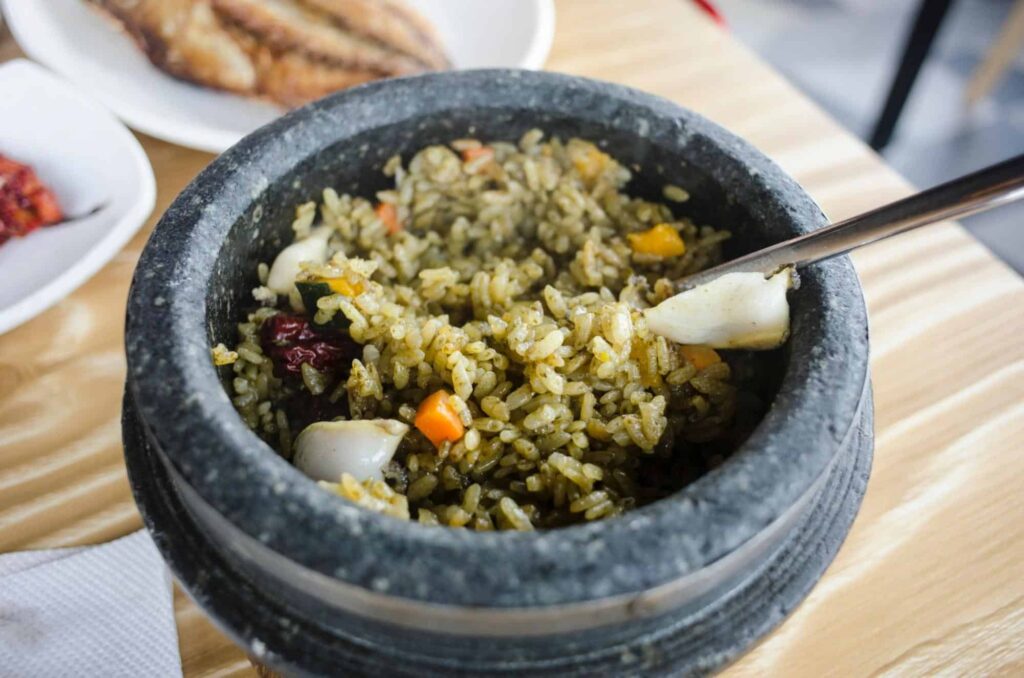
| Address | 335 Smith St, Chinatown Complex #02-197/198, Singapore 050335 |
| Opening Hours | Daily: 4:00 PM – 9:00 PM |
| Price | A bowl of rice starts at $5 |
The clay pot servings at Lian He Ben Ji Claypot are all made from scratch, explaining the long waiting time. But the wait is worth it when you’re served a piping hot combo of rice and tender, flavorful meat.
One of their largest servings of mixed rice (priced at $12) can feed two people or more if you’re both light eaters.
Oh, and did we mention that the stall is a Michelin Bib Gourmand recipient?
Zhong Guo La Mian Xiao Long Bao
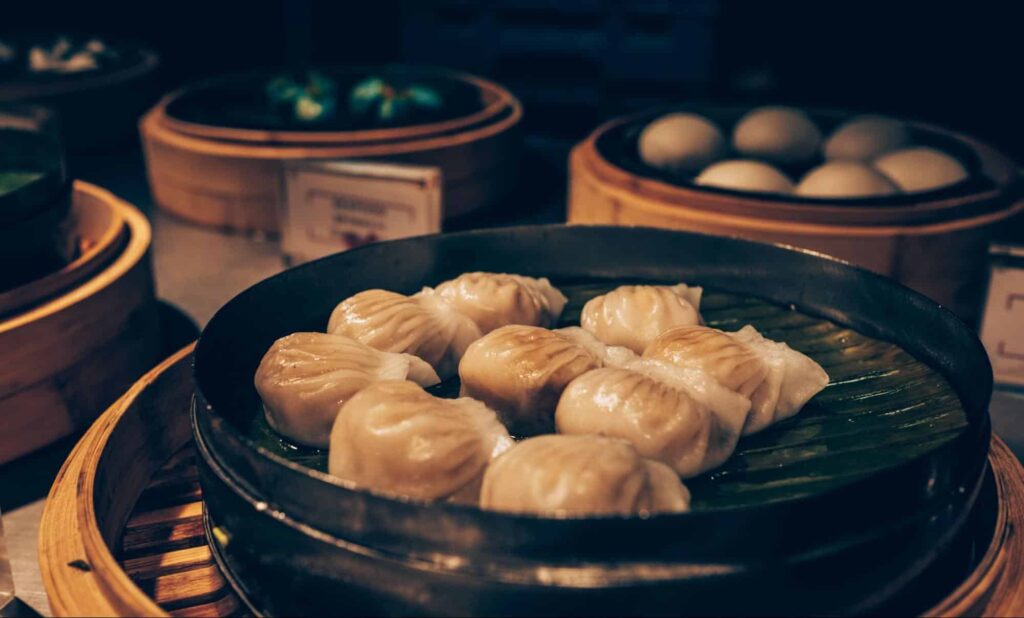
| Address | 335 Smith St, Chinatown Complex #02-135, Singapore 050335 |
| Opening Hours | Wednesday to Sunday: 11:30 AM – 3:00 PM, 5:00 PM – 8:30 PM |
| Price | Starts at $3.50 |
Steamed dumplings that come with a flavorful soup in every bite are Zhong Guo La Mian’s most popular dish.
That said, we also highly recommend trying their other offerings, including the addictive Szechuan Spicy Wanton and the surprising La Mian with Fried Bean Sauce.
And don’t forget the pan-fried dumplings. Seriously.
Xiu Ji Ikan Bilis Yong Tau Fu
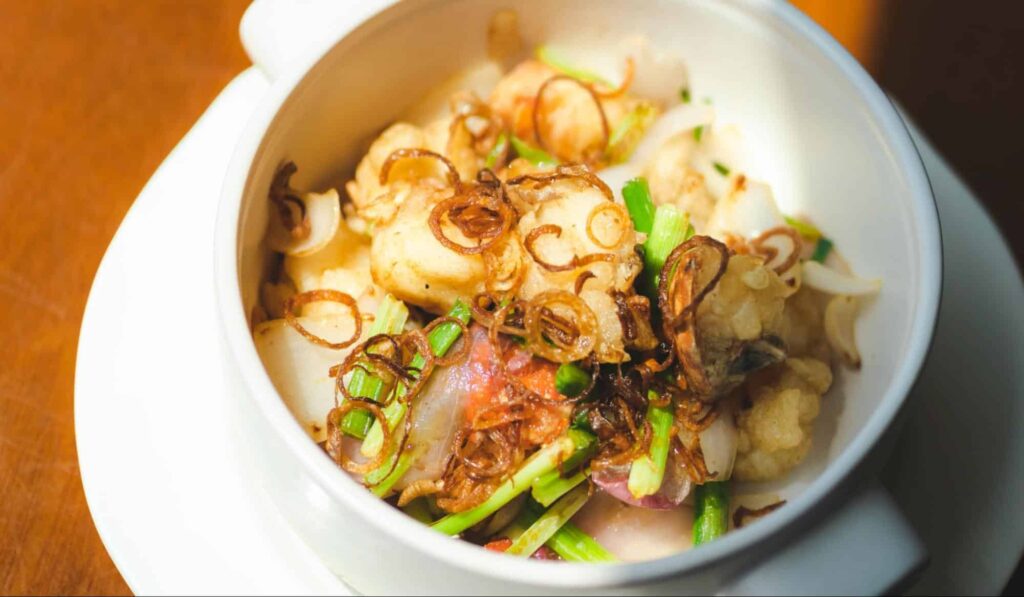
| Address | 335 Smith St, Chinatown Complex #02-88, Singapore 050335 |
| Opening Hours | Tuesday to Sunday: 5:00 AM – 1:30 PM |
| Price | Starts at $3.50 |
The long-standing Xiu Ji Ikan Bilis Yong Tau Fu stall serves clean-tasting and refreshing Yong Tau Fu, which is a nice break from the oft savory and rich-flavored dishes popular in the Chinatown Complex.
The crispy Ikan Bilis (fried anchovies) add a welcome, new dimension to the soup’s flavor.
The queue tends to be long, but the turnaround is, at best, tolerable.
The 1950s Coffee
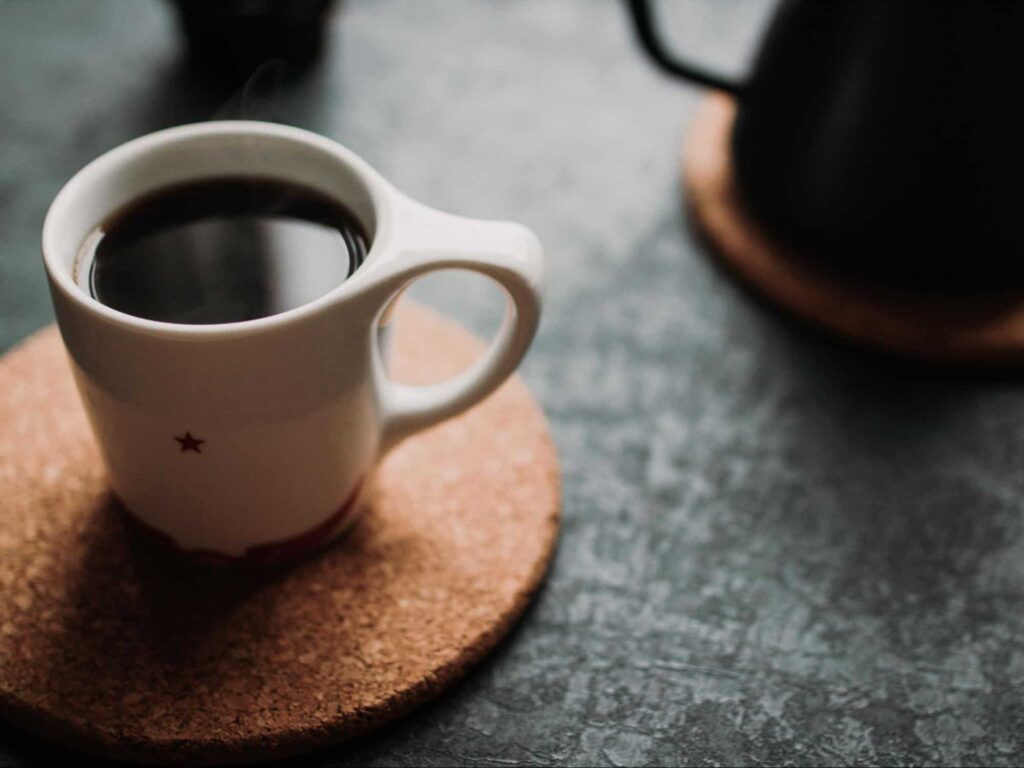
| Address | 335 Smith St, Chinatown Complex #02-048, Singapore 050335 |
| Opening Hours | Tuesday to Sunday: 7:00 AM – 5:00 PM |
| Price | Starts at $1.10 |
If you’re a coffee lover, it’s worth adding The 1950s Coffee’s local kopi to your repertoire. The black coffee is full-bodied and velvety and has just the right amount of bitterness, enough to kickstart your day.
Pair your cup of joe with their wide selection of toast or soft-boiled eggs for a filling breakfast.
Explore More: Other Chinatown Sites Worth Checking Out
Apart from our recommended to-do list, we have more sites that we think you should check out if you can spend more time in Chinatown, Singapore!
Singapore Musical Box Museum
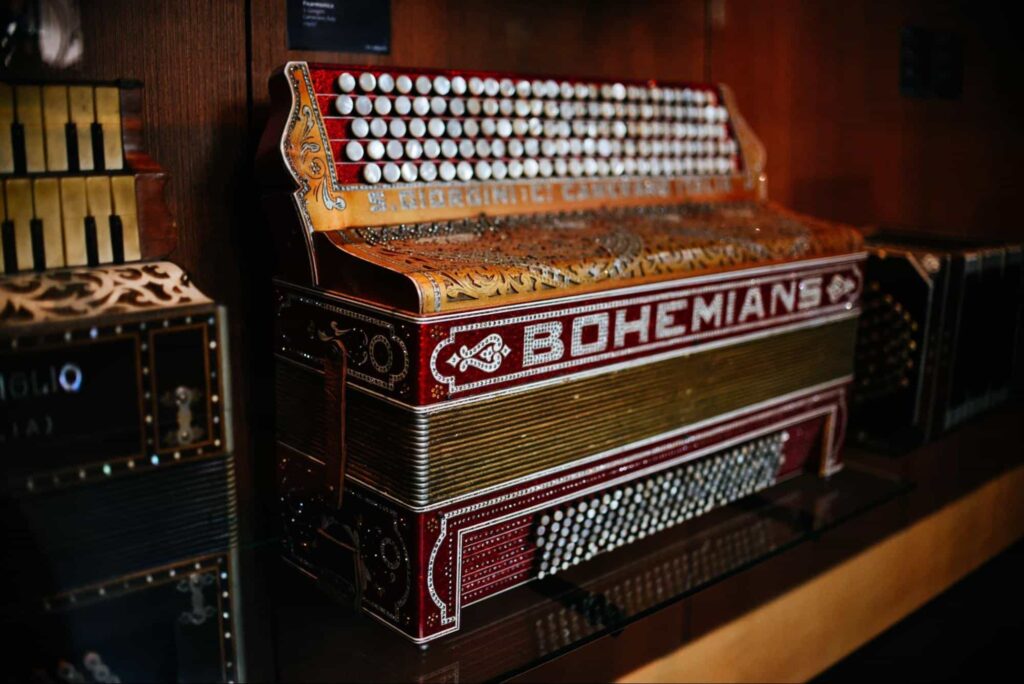
| Address | 168 Telok Ayer St, Singapore 068619 |
| Contact Details | +65 9864-6021 | smbmbox@gmail.com |
| Opening Hours | Daily: 11:00 AM – 5:00 PM |
| Rates | Adult: $12 Student/senior citizen: $6 Child (6 years old and below): Free entry |
The compact Singapore Musical Box Museum exhibits over 40 antique musical boxes hailing from Switzerland, Germany, and the United States of America.
A compulsory 40-minute guided tour will take you on a journey of the musical box’s history as part of European culture, how it’s made, and how it found its way to Singapore.
Note that the building has no wheelchair access.
NUS Baba House
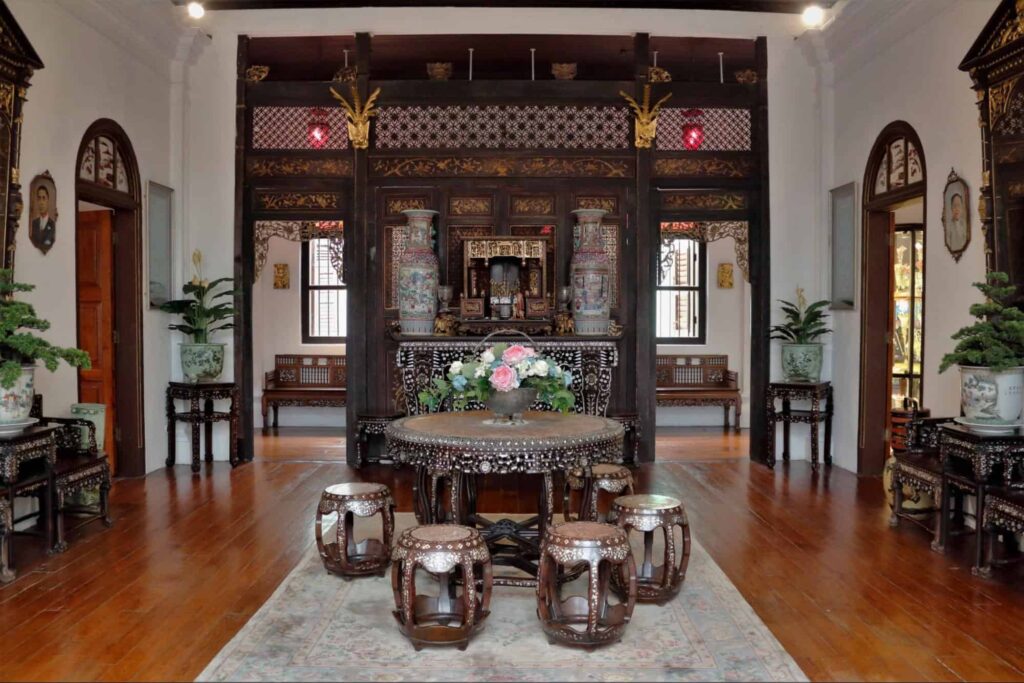
| Address | 157 Neil Rd, Singapore 088883 |
| Contact Details | +65 6227-5731 | babahouse@nus.edu.sg |
| Opening Hours | Tuesday to Sunday: 10:00 AM – 11:00 AM Saturday: 1:00 – 4:30 PM |
| Rates | Tourists: $10 *Free entry for Singapore residents, NUS students, staff and alumni, students with valid passes, and ICOM and Museum Roundtable members |
NUS Baba House—acquired by the National University of Singapore—will let you take a peek at the domestic setting of Peranakan Chinese family homes in the early 20th century. Well-preserved furniture and decorations give life to the house’s interior.
You can also check out the gallery space that displays contemporary Peranakan art and holds exhibitions on heritage conservation and social history.
Keong Saik Road
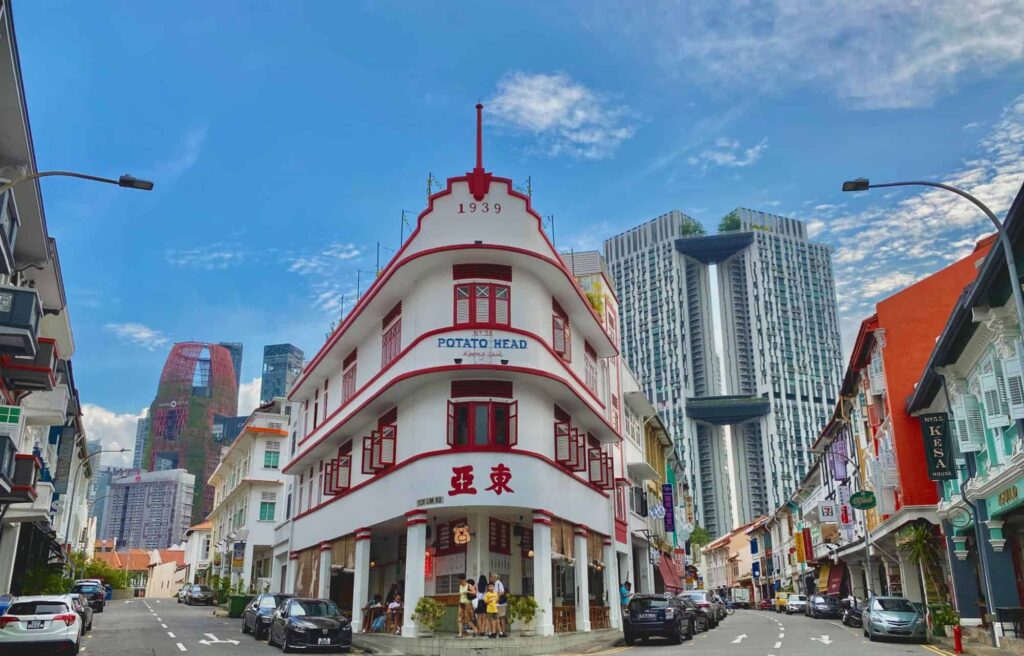
Down the road from Chinatown is Keong Saik Road which is known as a hipster hangout. It used to be a red-light district but thankfully is now transformed as a home to trendy boutique hotels and specialty shophouses.
You can also find the consistent Michelin star recipients Asian-French fusion Meta Restaurant and the Australian-centric Burnt Ends at the heart of this neighborhood.
What is Keong Saik Road famous for?
Completely different from its past reputation as a red light district, today’s Keong Saik Road is famous for its world-class restaurants and hip bars and as a vibrant hub for Singapore’s creatives.
Everton Park
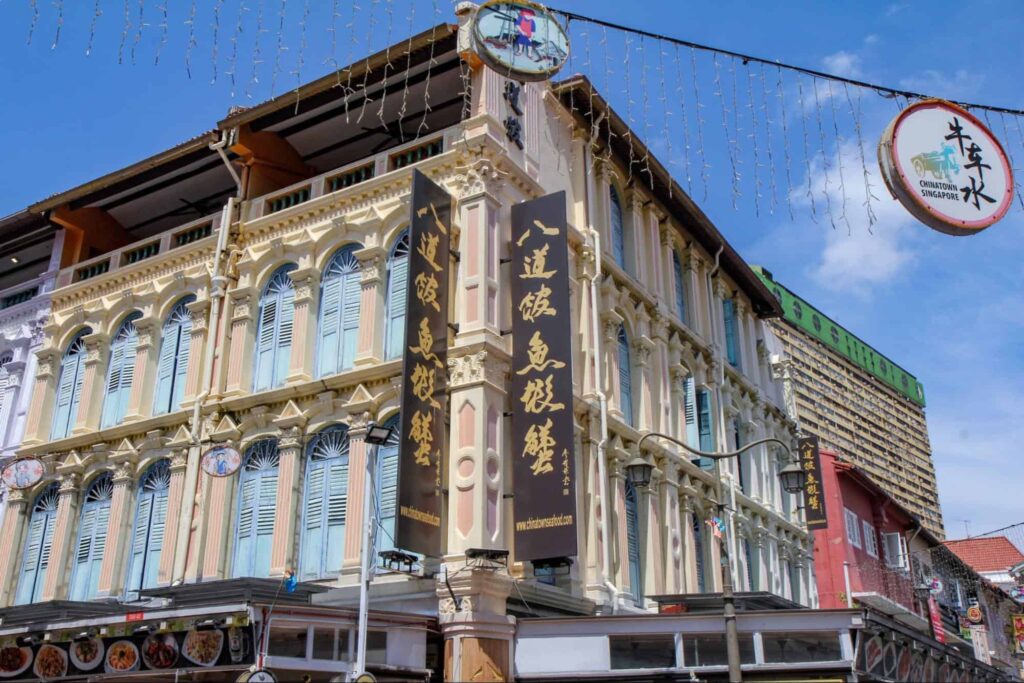
Everton Park at the edge of the Chinatown district can provide a quiet alternative to the latter’s bustling hawker centers. If you’re looking for rare items, the old shophouses in this neighborhood may just yield great finds.
Hipster cafes and lovely street art also dot this area, allowing for chill bonding moments over a cup of joe or a lazy stroll.
Pinnacle@Duxton Skybridge
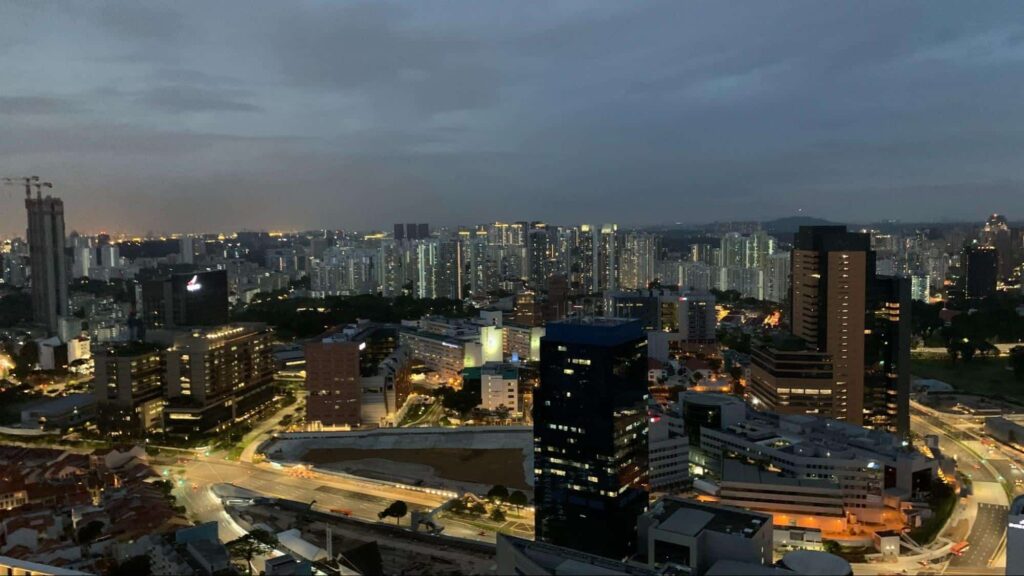
| Address | 1 Cantonment Rd, Singapore 080001 |
| Contact Details | +65 8683-7760 |
| Opening Hours | Daily: 9:00 AM – 9:00 PM |
| Rates | $6 via EZ-Link Card |
Ever wonder how Chinatown looks from above? The Pinnacle@Duxton’s Skybridge, located on the property’s 50th floor, lets you capture stunning views of the enclave and the nearby CBD for cheap!
We love that the sky bridge is fully furnished with wood decks, grassed areas, and plenty of seating, allowing the public to relax while looking at the lovely architecture below and the horizon.
Where to Stay: Top Accommodations in Chinatown, Singapore
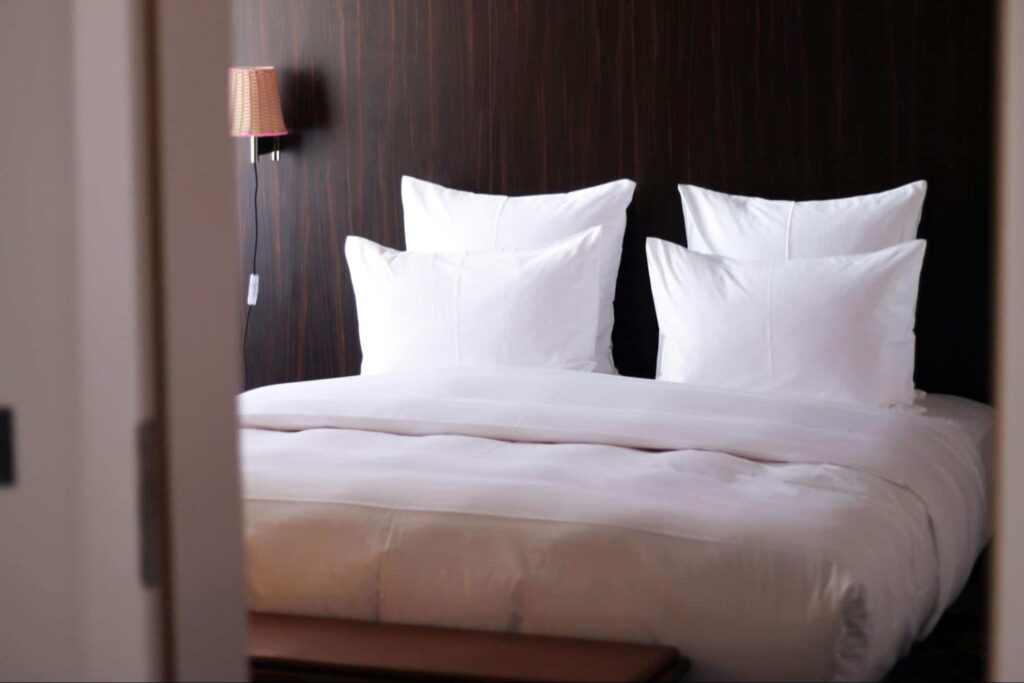
These hotels are strategically located near Chinatown’s top attractions, including the hawker stalls!
Amoy Hotel
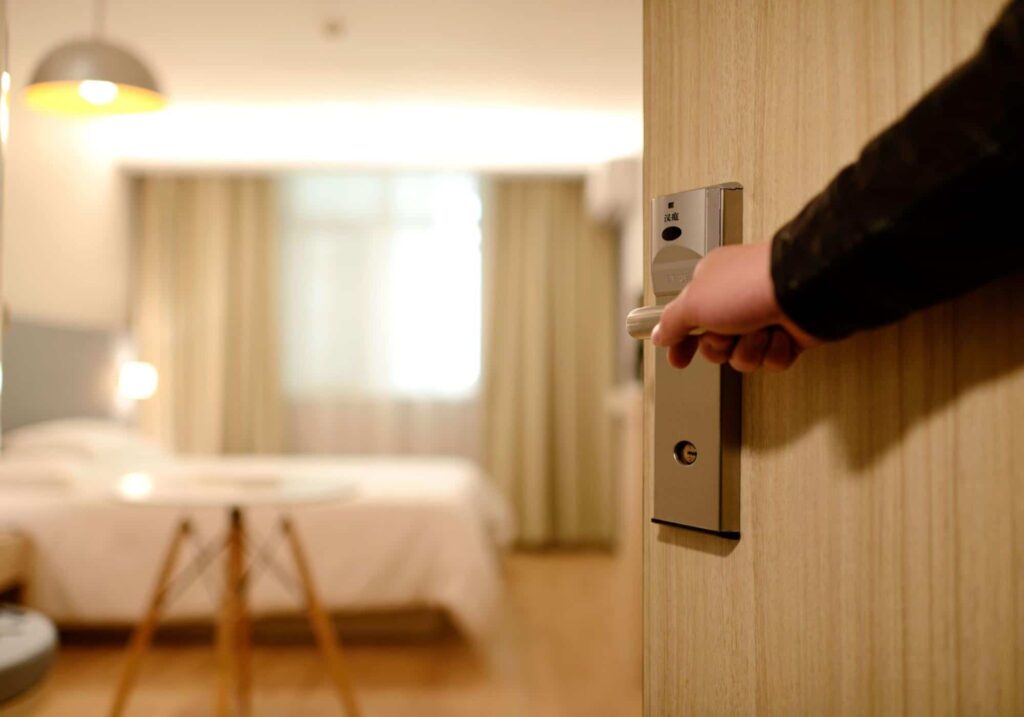
| Address | 76 Telok Ayer St, Singapore 048464 |
| Contact Details | +65 6580-2888, +65 6881-8888 | info.amoy@fareast.com.sg |
| Rates | Starts at $213 |
Amoy Hotel’s rooms are a combination of cozy and elegant, and modern and traditional. The space makes use of contemporary materials and colors, but designers are careful to incorporate Chinese heritage accents.
Each room comes with a complimentary minibar, coffee-making machine, and a bathroom with a rain shower and hairdryer.
KeSa House
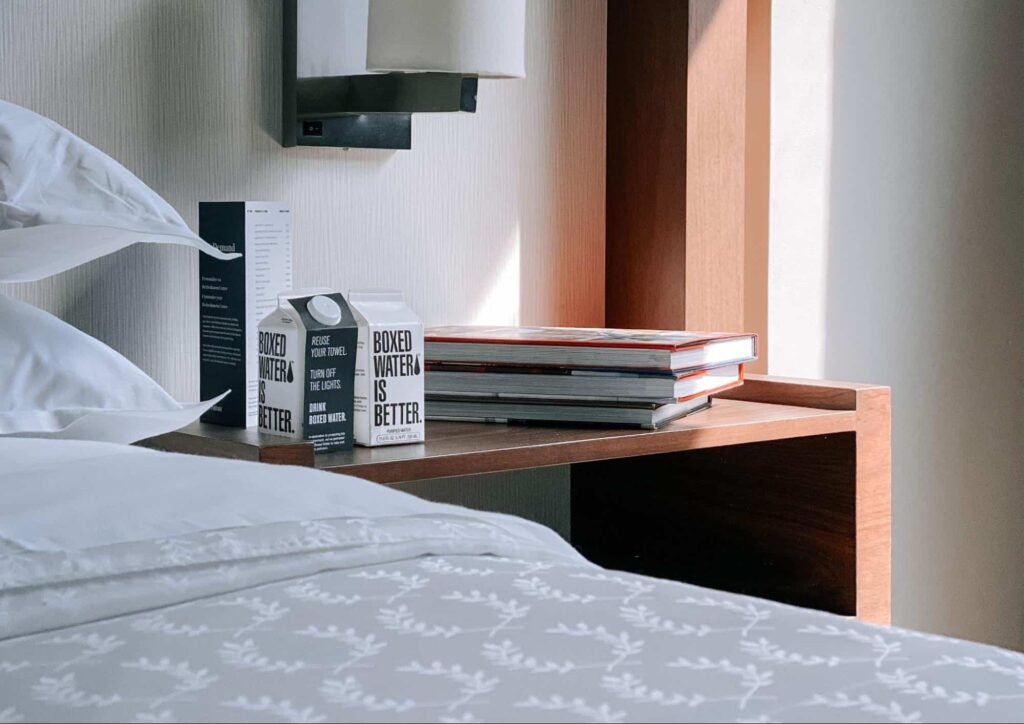
| Address | 55 Keong Saik Rd, Singapore 089158 |
| Contact Details | +65 6958-1588 |
| Rates | Starts at $210 |
The four-star KeSa House has a wide selection of rooms to accommodate various traveler needs, with the standard suites maximizing space while still looking cozy and the premier suites coming with a terrace and balcony for lush outdoor views.
We love that each room has a work desk and chair, perfect for those who can’t just leave their jobs even on vacation!
CUBE
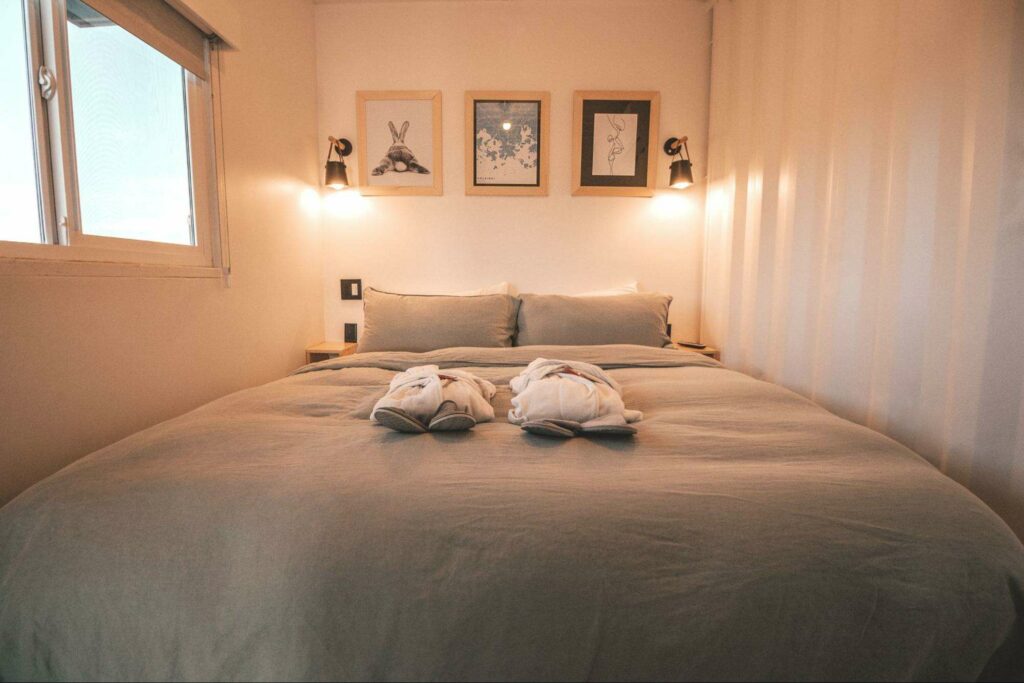
| Address | 76A/B, 78A/B Smith St, Level 2, #3, Singapore 058971 |
| Contact Details | +65 6221-7769 |
| Rates | Starts at $88 |
CUBE is a chic boutique capsule hotel that’s a nice alternative for travelers with a tight budget.
And while you can save a lot, you’re not giving up so much, as essential comforts are still in place including individual bathrooms, a self-help laundry area, concierge services, a shoe locker, and even a reading light!
The lounge and working space are shared, which is okay given that this is a one-star hotel. A modern bar is also available for further socializing over drinks.
How to Get to Chinatown, Singapore
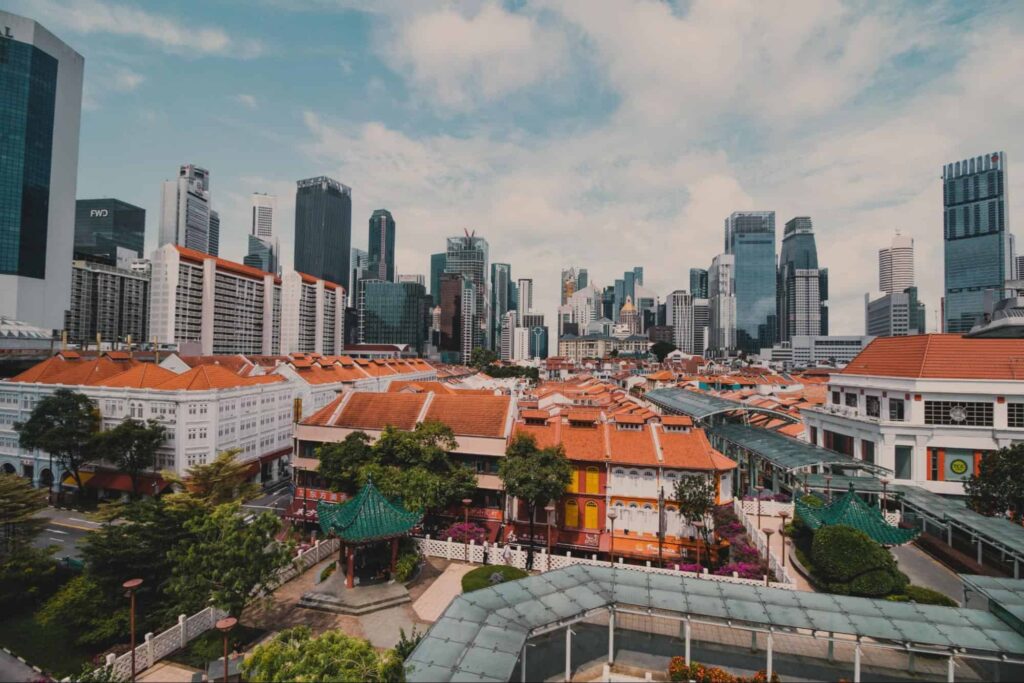
The best way to get to Chinatown is by boarding the Mass Rapid Transit (MRT) system. You’re bound to find a station wherever you are in the city, as the system connects planning areas around Singapore.
Board the station and buy a ticket to Chinatown, and voila, you’ll be there in minutes. We recommend purchasing a Singapore Tourist Pass for smoother point-to-point rides via the city’s public transportation system.
For your reference, a detailed map of the system is available to download on Chinatown’s official travel website.
How do I get a Singapore travel pass?
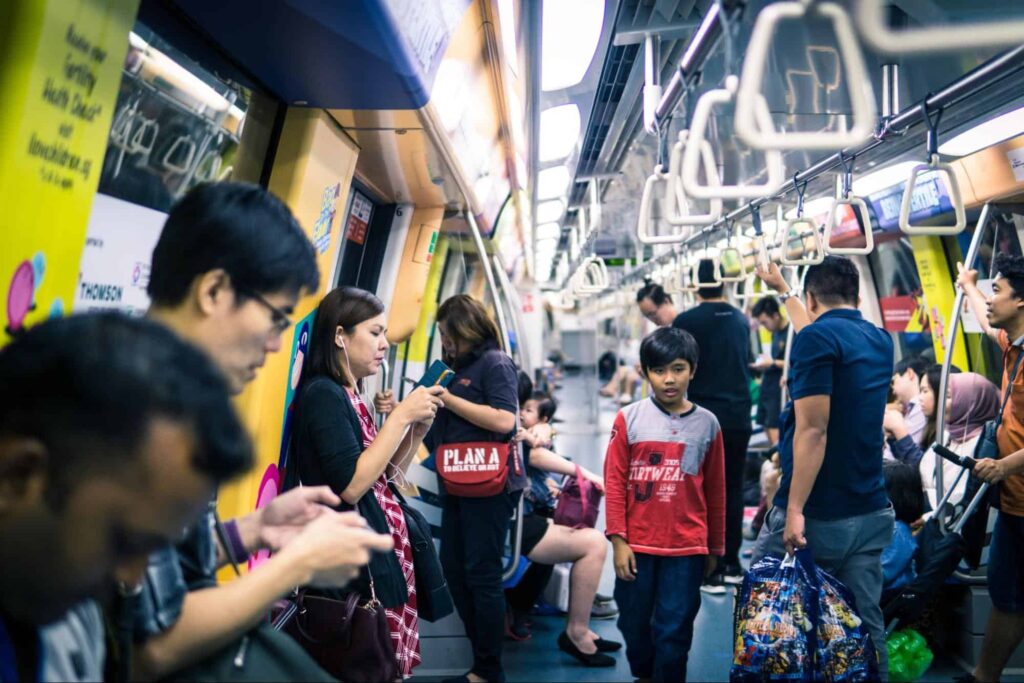
You can acquire your Singapore Tourist Pass by buying from a TransitLink Ticket Office at selected MRT stations.
The complete list of ticket outlets can be found on the tourist pass’ official site.
There are four types of passes to choose from, with varying prices and duration of use.
| Pass Type | Inclusions | Price |
| Singapore Tourist Pass | – Unlimited ride to the city’s public transport system* – Can be valid for 1, 2, or 3 days | Starts at $10 |
| SG Tourist Pass | – Unlimited ride to the city’s public transport system for 3 days | $25 |
| Singapore Tourist Plus Pass | – Unlimited ride to the city’s public transport system for 3 days – Additional attraction bundles | $38 |
| STP Charm | – Unlimited ride to the city’s public transport system for varying durations – Comes in a form of a trinket that doubles as a souvenir! | $36.90 |
Is the SG Tourist Pass worth it?
It’s worth purchasing an SG Tourist Pass if you plan to tour around Chinatown and nearby areas for three days. After all, the pass makes for convenient use of the city’s public transport systems.
If you’re staying longer, we recommend purchasing an EZ-Link card instead. Aside from being useful for public transportation, you can use this card for cashless transactions, which will make your trips much easier.
How to Get around Chinatown, Singapore
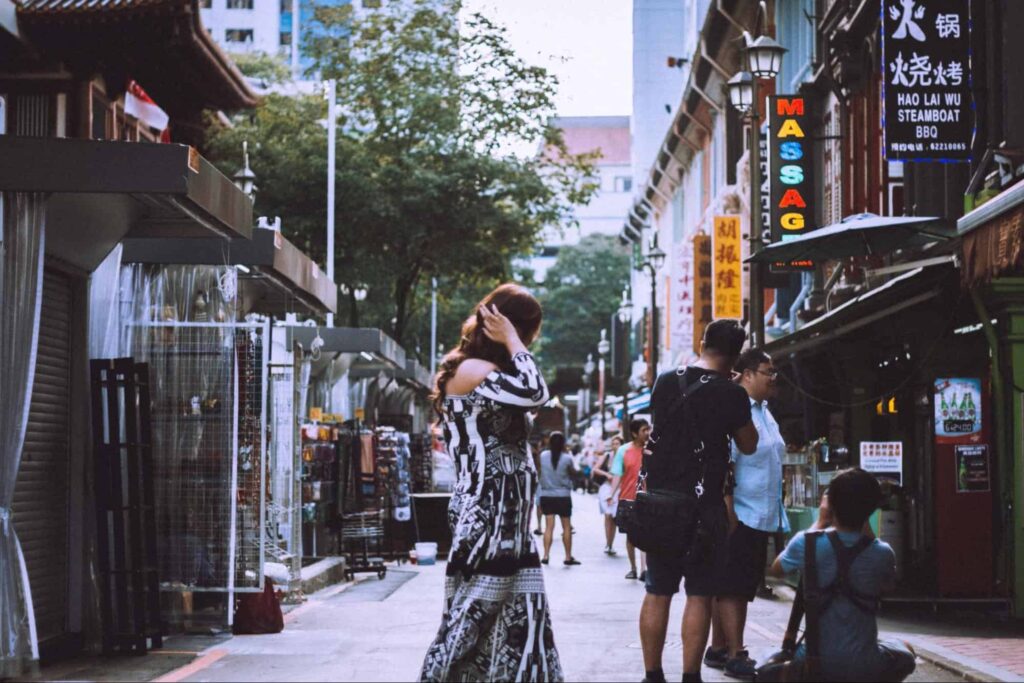
While you can certainly take the bus or hail a taxi to get around Chinatown, we recommend trying one or two walking trails to optimize your experience.
One recommended trail to see the most popular sites is to start from the Chinatown MRT Station.
From there, walk down Pagoda Street to see temples and the heritage center, turn to South Bridge Road for the murals and shops, then head to the Chinatown Complex near Trengganu Street to end your walk with yummy hawker food and Chinatown finds.
More walking tours are available at Chinatown’s official travel site.

